




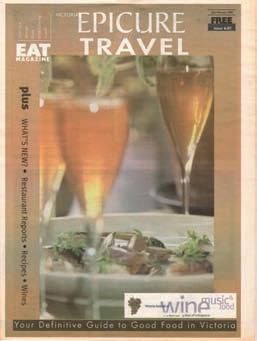










RESTAURANTS | RECIPES | WINES | FOOD | CULTURE LOCAL FOOD & CULTURE SEPTEMBER | OCTOBER 2018 ISSUE 22-05 INDEPENDENT & ISLAND OWNED FALL COMFORT cool weather cooking Fraser Valley Food Tour MasterClass - Gnocchi ® ON FRONT AND BACK COVERS, A SELECTION OF ISSUES SPANNING THE YEARS 1999 TO 2018

This is not an offering for sale. Such an offering must be accompanied by a Disclosure Statement. The Developer reserves the right to make changes and modifications to the information contained herein without prior notice. Specifications, sizes, layouts, availability and pricing are subject to change. Renderings, maps and photographs are representational only and may not be accurate. E. & O.E. Tenfold Projects Inc. VISIT OUR SALES CENTER ON LOCATION AT 453 HEAD STREET MONDAY TO WEDNESDAY 11–4 AND SATURDAY TO SUNDAY 12–5 CALL 250-384-2771 | WESTBAYQUAY.COM A stunning collection of 85 homes found at the foot of a dynamic marina community fully outfitted for the best in life. VICTORIA’S OCEANSIDE NEIGHBOURHOOD
To everything, there is a season.
EAT su ffered a loss at the beginning of the summer that knocked the wind out of us. The founder, publisher, and editor of EAT, Gary Hynes, passed away unexpectedly. Suddenly, there was a gaping hole in the fabric of our business, and in the food community at large.
Through the summer, we missed our leader, our editor-in-chief. But the EAT team is a unit and strong together. Thank you to our advertisers for standing with us at this sad time.
The EAT team has started work on the Nov/Dec Holiday issue, and are planning the issues for 2019.
We give the editor’s note to Gary one last time.
The EAT team
CITY EATS
Here are some recent and upcoming highlights:
After much anticipation, Sherwood Café and Bar has now opened in the new Douglas House building at 720 Pandora. Chef Matt Chamberlain is at the helm in the kitchen and has introduced a tempting menu with something suitable for every time of day. Inspired by the European café/bar model, Sherwood is open from morning to midnight every day, with seating for 55 inside and 14 on the patio. sherwoodvictoria com
The Breakwater Café Bistro Bar at Ogden Point has now opened the Tasting Room in their basement and a food truck. The Tasting Room features a local and seasonal focus, including a kale gomae made with local bullwhip kelp, as well as carefully curated cheese and charcuterie options. breakwaterbistro ca
A couple of Vancouver-based businesses have now opened locations in Victoria. The Flying Pig has opened at 1245 Wharf St. While the name suggests a pork-heavy menu, this is not, in fact, the case, but rather alludes to their “desire for you to see the impossible happen every time you visit.”

“For me, fall is a time for travel. I long to get out there to discover new places, cultures, and foods.”
“There are so many reasons to celebrate the return of autumn; the sun begins to set earlier and the nights bring a welcome cool, making it easier to sleep. I get the spring back in my step, and my cooking is more energetic. My thoughts turn to slow-braised pork, pear Tarte Tatin and my addiction to cheese returns—runny Brie de Meaux or an earthy Tomme are paired with a baguette. Intense red wines are savoured in big Riedel wine glasses. “
“…from large family dinners at Thanksgiving to smaller, more intimate get-togethers like ones celebrating the last warm evenings on the deck. This transition from summer to winter on Vancouver Island is one of my favourite seasons of the year.”
Masthead
FOUNDER
Gary Hynes
PUBLISHER
Pacific Island Gourmet
CONTRIBUTING EDITOR
Carolyn Bateman
VANCOUVER CONTRIBUTING EDITOR
Julie Pegg
SENIOR WINE WRITER
Larry Arnold
LAYOUT AND DESIGN
M. Annett
C. Annett
PRODUCTION
Amanda Batchelor
REGIONAL REPORTERS
Milano boasts a “West Coast heart. Italian soul.” They are open from 7am-7 pm at 817 Government St, serving coffee roasted at their roasting facility on West 8th Ave in Vancouver. theflyingpigvan com and milanocoffee ca
Shaka Bowls is a new food truck serving up smoothie bowls around Victoria. Follow streetfoodapp.com to keep track of their whereabouts. streetfoodapp com
Cacao 70, a Montreal-based business is set to open a Victoria location at 640 Fort St. This will be one of their “Sweet House” businesses, serving chocolate drinks, desserts and all-day brunch items.
Melanie Laverick, the mastermind behind Empire Donuts is doing Victoria another huge favour and opening Empire Fried Chicken at 109-230 Cook St. empiredonuts ca
Pang has opened at 762 Broughton Street. Chef Jeff K alesnikoff , who helped open Foo Ramen Bar in the same location back in 2014 is the driving force behind the business, which offers eat in or take out options with bold Asian fusion fl avours from 11am-4pm Monday-Friday. pangvic ca
Tofino Ucluelet, Jen Dart
Victoria, Rebecca Baugniet
Cowichan Valley-Up Island, Kirsten Tyler
Vancouver, Jennifer Carter
CONTRIBUTORS
Larry Arnold
Joseph Blake
Isabelle Bulota
Marie-Eve Charron
Cinda Chavich
Pam Durkin
Lindsay Eden
Lillie Louise Major
Sherri Martin
Elizabeth Monk
Daniel Murphy
Daisy Orser
Elizabeth Nyland
Adrian Paradis
André Rozon
Adrien Sala
Shelora Sheldan
Shawn Soole
Jill Van Gyn
Johann Vincent
Rebecca Wellman

SENIOR ACCOUNT MANAGER
Susan Worrall
SALES
Ron Metella
FACEBOOK/EATMAGAZINE
TWITTER/EATMAGAZINE INSTAGRAM/EATMAG
For advertising and other inquiries:
PHONE 250-384-9042 / 778-350-6962
EMAIL editor@eatmagazine.ca accounts@eatmagazine.ca sales@eatmagazine.ca



ONLINE
EatMagazine.ca
MAILING ADDRESS
Box 5225, Victoria, BC, V8R 6N4

STOCKISTS
EAT is delivered to over 300 pick-up locations in BC. Visit our website for locations.
PRINTED IN BRITISH COLUMBIA EAT® is a registered trademark.



Est. 1999

250.590.7424 VISAVISOAKBAY.COM @VISAVISOAKBAY new fall collections salt spring island Pod Eat Dots.indd 1 6/4/18 8:22 AM Welcome
/ OCTOBER
SEPTEMBER
3
FOOD MATTERS PLOUGHMAN’S LUNCH
A humble meal for a humble man

UNABLE, REGRETTABLY, TO MAKE GARY’S MEMORIAL servic e I figured I’d honour him in my own way. How? A ploughman’s lunch on the day of seemed right and fitting. A good ploughman’s is honest, unfussy, with no “tricksy ” fl avours or preparations; neither is it a slave to culinary fashion. These qualities spring to mind when I think of Gary and his approach to food and to EAT.






Sharp farmhouse English cheeses and hunks of rustic bread are the foundations of a Ploughman’s. Add-ins to the lunch may vary, but they too should remain homey, preferably handmade, and not be over-thought or over-embellished. An authentic ploughman’s keeps things attractively simple. (Although bread and cheese had been a farmer’s mainstay for centuries, with the de-rationing of cheese in 1954, nine years after World War II, the British Milk Marketing board popularized the term Ploughman’s to foster the sale of the country’s cheeses.)
Amidst today’s penchant for charcuterie and cheese plates, the lack of the ploughman’s lunch in restaurants and pubs, or at home, surprises me for this British pub standard lets

farmer, cheese maker, baker, butcher, and brewer shine. (No ploughman’s should ever be without good ale to wash it down.)

A ploughman’s can be a mere chunk of crusty bread torn right from the loaf for munching with a wedge of aged cheddar and slices of tart juicy apple plucked right off t he edge of the knife. But it can also be an assemblage of wholesome breads, creamery butter, and one to three crumbly or hard cheeses—one of which must be blue-veined (creamy soft cheeses not allowed). A thick slab of country ham with English mustard is a perfect addition. Tangybut-not harsh pickled onions and/or homemade brown or Branston™ pickle are the usual condiments. Halved hard-cooked smallish farm eggs, or quartered Scotch eggs, are lovely; so are a few slivers of pork pie. Sliced, peppery radishes and celery stalks are all the salad that’s needed.
A favourite lunch memory is a ploughman’s plate in a seaside pub in Aldeburgh, in Su ffolk County, UK. Rather than going for the county’s renowned local ham, I opted instead for the equally wonderful, locally smoked herring. The sweet char of the fi sh matched marvelously

A bene t for the Belfry Theatre Join us! Tickets $95 Includes a partial tax receipt Crush 2018 A Fine Wine A air Fine Wine Live Auction Wine Tastings 250 385 6815 www.belfry.bc.ca/crush Cuisine Pairings Joey Smith Trio Sunday, October 21 · 5 –8pm Delta Ocean Pointe Resort Generously supported by QUALITY, CREATIVITY, & EXECUTION Fall's arrival delivers amazing fresh local ingredients, rich aromas, and full avours to maximize your dining & beverage experience. Down the Hall, 506 Fort St. www.li�lejumbo.ca 778.433.5535 Reserva�ons advised ‐ online Open 7 days a week 5 PM un l
4 SEPTEMBER/OCTOBER 2018
with the cheeses, and particularly the local ale. I read recently that Cornwall folks often fl ake smoke d fi sh into a ploughman’s lunch too. Here at home, smoked salmon or even better, smoked trout, step up to the plate quite nicely.

A ploughman’s lunch is the perfect occasion to haul out your thick wood-grain cutting board, vintage cotton cloth, and napkins (mismatched i s fi ne), crockery or pottery plates, beer mugs and sturdy cutlery—or just use you r fi ngers for breaking off hunks of bread and cheese. Whether you dig in at a picnic table, kitchen table or graze from a ploughman’s platter set on the coffee table in front of a toast y fi re, the fare is pure country comfort. Never make a sandwich of a ploughman’s platter. Each tangy, crunchy, smooth, grainy ingredient should speak for itself.
My homage-to-Gary ploughman’s platter was made up of Canadian farm and British

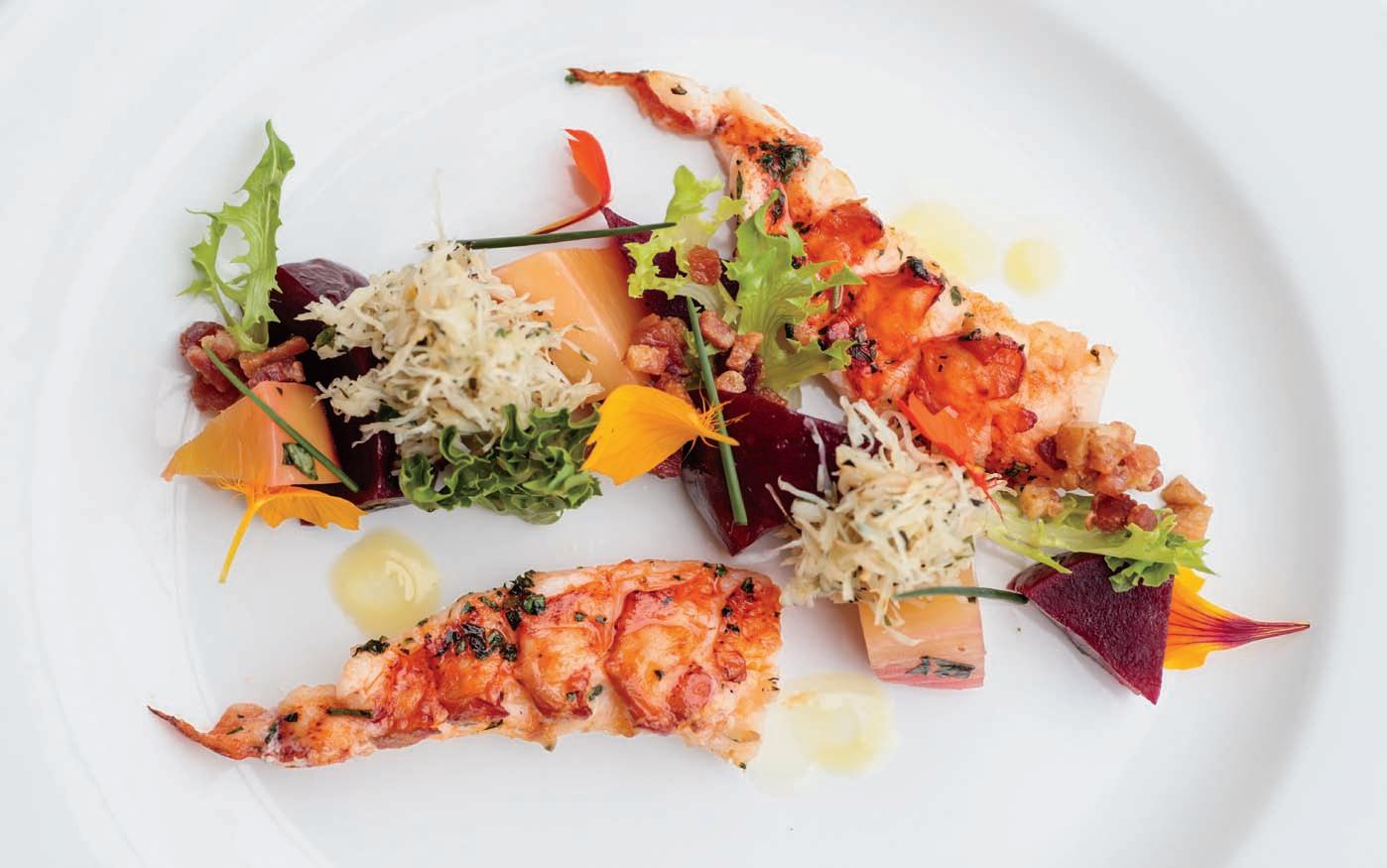
Ingredients:

products that I had on hand. It was eaten while watching episodes of “The Mind of a Chef”. I am sure Gary would have approved of this simple feast—and enjoyed.
Plenty of on-line recipes come up when you Google “malt vinegar pickled onions”. I recommend following the recipe on culinaryginger.com. You might need a little patience however with the pop-ups and lengthy intro text.
A recipe for making quick thinly sliced pickled onions appears on page 183 of EAT’s own Island Wineries of British Columbia (2011).
Homemade ploughman’s pickle, a version of Branston™ pickle is an involved process but an excellent way to pass a cool autumn day. Canadian Living magazine (canadianliving.com) offers a recipe (August 18, 2008) for English Brown Pickle.
Walnut and onion & white sourdough breads from PICA (Pacific Institute of Culinary Arts) student bakery
Butter
Shropshire Blue, a deep orange cheese streaked mightily with blue veins, white Cheshire, and local double-smoked Gouda from the Coquitlam Sunday farmer’s market (I snuck that last one in—a bit unorthodox but delicious).
Jackson’s Meats country ham and smoked trout from the St. Norbert farmer’s market from a recent visit to Winnipeg
Coleman’s mustard
Halved hard-cooked organic eggs, bought from a Ladner farm. Malt vinegar pickled Okanagan onions, and brown pickle (both made by me).
Persephone Best Bitter from Gibson’s BC (English style bitter, not often made here—malty, lightly hopped, mildly fruity)
Toque
WWW.TOQUECATERING.COM VICTORIA I VANCOUVER I WHISTLER
JULIE PEGG
JULIE PEGG
5
Eating Well For Less
Soupa Café

736 VIEW ST, IN ST. ANDREWS SQUARE MALL, 250-380-0856
Underneath an office tower, deep in the heart of downtown, is clustered an enclave of small cafes known only to residents of Victoria who head there to meet their financial planners or, more fun, go to Empire Donuts. The causeway underneath the office tower is actually quite airy, so the seating at these cafes is comfortable. And what could be more comforting than soup? Soupa Café offers a soup and stew bar. Three classics are always on the menu: Red Lentil Mulligatawny, Chili Con Carne, and Chicken Stew. The chili and the chicken are robust, hearty comfort food classics, and for something zippier, the Red Lentil Mulligatawny is delicious. It’s more of a dal in texture than a soup, and has a strong, fresh hit of lemon. There are also numerous soups and stews on rotation. I really enjoyed the African Peanut Soup, a gluten-free and vegan option, which is sweet and creamy, and also filling thanks to cubes of squash, as well as chickpeas and tomatoes, mixed in. Mexican Chicken Ole soup has a rich, inviting stock tinted golden brown from its homemade chicken stock base, tomatoes, and chili pepper and other spices. The lima and kidney beans in the soup complement the shredded chicken. All the meat soups and stews, including a slice of bread and toppings, are $9.45 for 12 ounces, and $10.45 for 16 ounces; vegetarian ones are $8.99 for 12 ounces , and $9.45 for 16 ounces.
If you are still in a summer headspace, the Summer Salad for $10.99 is fresh and well-balanced, with quinoa sprinkled on a bed of spinach, and then topped with

peaches, strawberries, dried cranberries, almonds, pumpkin seeds, and chevre, and then tossed with a red wine vinegar dressing.
Owners Avi Lugassy and Carly Murray have given their employee Alicia, a barista, room to play and invent, and she has created an iced coffee with a homemade syrup that is both delicious and dramatic to look at. Her Darjeeling iced tea is tart and lemony. Be sure to ask what her latest invention is.
Soupa also has an outpost in the Jim Pattison Toyota building at Finlayson and Douglas, which is an excellent reading hideout for when loved ones are at Mayfair Mall. Another way to check them out is at their booth at the Gorge Waterway Cleanup on September 22.
ELIZABETH MONK
6 SEPTEMBER/OCTOBER 2018
RED LENTIL SOUP AND SANDWICH



AGRIUSRESTAURANT.COM 732 YATES ST. | 778.265.6312 BY FOL EPI Agrius FE Eat Mag_Feb2.indd 1 2018-02-03 10:35 AM WWW.HESTERCREEK.COM/50TH 7
Open daily 10am-5pm
Wine by the glass or bottle; charcuterie platters and more.

bluegrouse.ca

well with changing seasons
Pairs
2182 LAKESIDE ROAD, DUNCAN, BC 8 SEPTEMBER/OCTOBER 2018
BLUEGROUSEWINES
Eating Well For Less

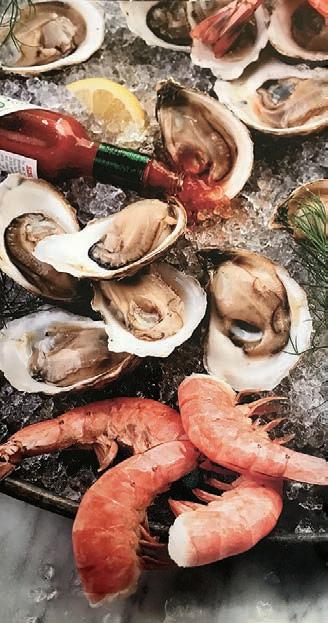
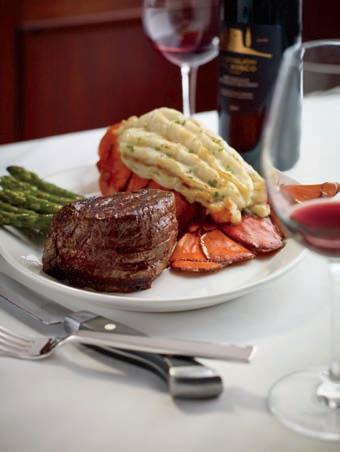

Little June
1301 GLADSTONE AVE, AT FERNWOOD RD, 250.590.7307








I can’t talk about Little June without talking about The Parsonage. Fernwooders feel very possessive of The Parsonage Café, or should I say “neighbourhood hub,” which recently moved to Cook and Caledonia. But it’s easier now for Fernwooders to share the space with others because the owners of The Parsonage have teamed with the owners of Fernwood Coffee to bring us Little June, which has elements of The Parsonage, and some of its own Europea n fl air. The concept is “fast fi ne”: this means the food has a touch of elegance but is ordered as counter service. I recommend targeting the baked eggs category on the menu if you are looking for something di fferent. The Baked Eggs and Ham features local sous-vide poached eggs on a bed of paper-thin ham from Four Quarters, with Emmental cheese on top, served piping hot in a cast iron pan for just $8. Also served up this way are a version with chick peas and a parsley and cilantro-laden house green sauce, and one with cubes of smoked bacon in spiced
tomato sauce. All of them are satisfying and fl avourful. Little wa ffles for $5 work well for a meal or a snack. The savoury Green Onion Wa ffles are like Chinese green onion pancakes, only flu ff y, and are served with a soy and chili oil dipping sauce.
Vitally important to know is that, unlike previous cafes at this location, Little June has a liquor license. I have just texted my on-the-market bachelor friend this tip, and now I am telling you: this is a great place for a getting-to-know-you date – but since this business is new, do check the website for updated hours. You can go the route of beer and Housemade Bar Nuts ($4), or the route of wine and Carmelized Shallots Dip and Chips ($6). How you brand yourself for the date is not my business, but be assured that the food will be good, and the non-Starbucks date location will show that vyou have a touch of casual elegance and originality – much like Little June cafe.
106 Superior Street | 250.380.0088 | IlCovoTrattoria.ca Cucina Italiana RUSTIC, FRESH & AUTHENTIC Dinner Happy
Lunch 1001 Wharf St, Victoria Reservations: 250-380-2260 nauticalnelliesrestaurant.com ELIZABETH MONK
Hour
EGGS WITH CREAMED CHICKPEAS AND GREEN SAUCE
9
JACQUELINE DOWNEY PHOTOGRAPHY
HEAR THE THUNDER
253 COOK ST. VICTORIA, 250-384-6090










Thunderbird is the latest entry into Victoria’s growing Korean food scene.

Chicken is the mainstay of owner Tony Yeom’s new menu, the restaurant’s name inspired by the neon thunderbolts that grace the walls, remnants of the vintage 1950s diner that once occupied this Cook Street Village space.
“Thunder and bird,” he explains, referencing his specialities of Korean fried chicken (KFC), crispy chicken cutlet burgers, and Bi Bim rice bowls topped with pickled vegetables, soft cooked eggs and chicken katsu.
I can see those neon thunderbolts reflected in Yeom’s glasses as the friendly, young restaurateur tells me how his training in hotel management at Toronto’s Centennial College, and stints working in hotels and restaurants across western Canada, brought him to this latest venture.
“I’m not a chef, but I really missed Korean fried chicken,” says Yeom. “My friend owned a chicken place in Korea and I thought ‘I can do that.”
When Yeom won $50,000 in a 6/49 lottery, it was his chance to branch out on his own and make that dream a reality. He perfected his fried chicken recipe, then teamed up with a partner to open Chicken 649 on Quadra Street last fall. The tiny take-out joint was an instant hit and remains a popular place for locals looking for a fast fried chicken fi x.
But Yeom wanted a larger restaurant where he could welcome customers and use his frontof-the-house skills. So when he heard that the all-day breakfast joint on Cook Street was closing, he sold his stake in Chicken 649 to his partner and opened Thunderbird.
While Yeom can jump into the kitchen when needed, he’s hired chef Claude Joo to head up the back of the house. Joo studied culinary arts at George Brown College in Toronto, and worked at Toronto’s Momofuku and Alberta’s Fairmont Jasper Park Lodge, before returning to Victoria this summer (where he once studied English) to help open Thunderbird. He also had his own KFC shop in Korea.
Joo brings big city skills and technique to the menu, from his scratch sauces (I love the sweet heat in his searing VS sauce, combining ghost, Serrano and Thai bird’s eye chilies with maple syrup and pickled turnip) and subtly spiced Yang-Nyeom KFC. The Bi Bim bowls stray slightly from the traditional, too, with delicate jasmine rice, house pickled cabbage and cucumber, and a slow-cooked, sous-vide egg on top.
The chicken here is a step up – whole, free-range birds that Joo butchers himself before








CINDA CHAVICH 10 SEPTEMBER/OCTOBER 2018
battering with a light karaage-style coating made with potato starch, and double frying for a shatteringly crisp result. All parts are served, with white and dark meat fried separately to achieve perfectly cooked results, he says.


Joo uses buttermilk batter for his katsu chicken cutlets, which are then coated in a combination of panko and brioche breadcrumbs, for his burgers and bowls. The Chun-Cheon burger is topped with gochujang chicken that’s marinated in the famed Korean sauce before being grilled, dakgalbi style, and piled on a brioche bun with deep fried sweet potato, pickled daikon and nori aioli.

Salads include spinach with pickled and compressed strawberry, blueberry, roasted pumpkin seed and feta, and a romaine bowl with pickled daikon, red radish, cucumber and soy ginger vinaigrette. A cabbage, apple and celery slaw with honey poppy seed dressing is served with the KFC meal. Even the house Thunder Mayo is made from scratch – a recipe Joo says includes Sichuan mala sauce spices.
And he’s already ri ffi ng on ideas for an Asian-fusion breakfast menu, and smaller tapasstyle Korean plates to share.






Yeom says diners are already “ flocking” his larger, 50-seat space for the expanded Korean menu – I can hear the thunder is rolling in!
 CINDA CHAVICH
CINDA CHAVICH


INGREDIENT-DRIVEN DISHES, SOURCED AND FORAGED FROM TOFINO’S OCEANS, SHORELINE AND FORESTS Tofino Resort + Marina 634 Campbell Street • (250) 726-6122 tofinoresortandmarina.com 1909kitchen Shared plates, family-style
PHOTO
11
COURTESY OF THUNDERBIRD
EARLY OPPORTUNITIES
Getting started at EAT
TEXT: ADRIAN PARADIS
IN THE WAKE OF ANY LOSS, it is easy to dwell on what is suddenly missing, but far more constructive to instead focus on what effect was left behind. In the weeks that followed Gary Hynes’ passing, a slew of people wrote of how he gave them thei r fi rst real magazine opportunity or had taken a chance on them to publish thei r fi rst food article. It could even be said that there is a small army of publishers, writers, and photographers working today who may not have got their start if it were not for the generous nature of Gary. Here, I caught up with a few long-time contributors to EAT Magazine, some of whom have gone on to other projects and some who are still working at EAT today. All, however, told a similar narrative of being inexperienced, but eager to work and how Gary was patient, supportive, and willing to give them that early opportunity.
Treve Ring
Treve Ring has done a tremendous amount of wine writing and journalism. To name a few of her accomplishments, she is the national managing editor of WineAlign, executive editor at Gismondi On Wine, BC editor for SIP Northwest Magazine and wine editor for Scout Magazine.

Despite the mountain of work done today, in 2001, Ring was recently back in Canada after fi nishing her post-graduate history of art studies in London. Starting to question her fi rst career trajectory, she emailed the magazine she had read and loved for so long wondering if she could somehow fi nd freelance work. “Gary took a chance on me and started giving me small assignments,” she says. Being a vegetarian at the time, Gary gave her articles for veggie-based plates and restaurants
as she started becoming very active with the publication.
“I couple of years into it, I found I was really more interested in what was in the glass, rather than what was on the
plate,” she says. “I was only about 22 or 23 at the time; I really had no wine background, so I started taking wine classes.” While doing her sommelier training, Gary supported her and provided her fi rst experiences to write about wine, beer, and spirits.
In 2013, after helping to launch the EAT website and working as the drink editor and online editor, Ring found she was away traveling for more than half the year at a time and could no longer effectively write about local happenings. “I feel very fortunate to have started with EAT and to have grown with the magazine for over a decade,” she says. “That’s 100 per cent why I am where I am today in my career. If I hadn’t met Gary and started writing for EAT, I’m positive I wouldn’t be a wine writer today.”
Heidi Fink
Heidi Fink is proli fic in her work around town. She is a red seal chef and has been teaching cooking classes in Victoria since 1999. Additionally, when she’s not cooking, she’s writing about food for her blog, or for her food column.

Back in 2002, however, she was yet to be published and still exploring her career options. Having a one-year-old at home, she was looking to get out of the late-night restaurant life, and so she pitched Gary an article about cooking with lard. “I wasn’t sure what to expect at fi rst, but he was so
gracious and positive and enthusiastic to read the article,” she says. “I didn’t realize until after I had submitted the article how much of a risk it was for him. I remember stressing out because it was about 200 words over what he had requested. I sent it to him kind of nervous, but he thought it was great.”
Perhaps more importantly than just publishing her fi rst article, Fink says that once Gary had con fidence in her, he would ask her for more content, promote her as a writer, and work with her to improve her writing. “That was almost more important,” she says. “It wasn’t a one-shot deal with him. It was a relationship he was willing to work on.” Fink wrote for EAT until 2013, while still juggling her cooking classes, food tours, and at-home-life.
“Not just giving me my start, but Gary’s faith in me and willingness to publish me gave me so much exposure and practice,” she says. “Any opportunities I’ve had since then have stemmed from that for sure.”
Recollections
“It wasn’t a one-shot deal with him. It was a relationship he was willing to work on.” —HEIDI FINK
12 SEPTEMBER/OCTOBER 2018
REBECCA WELLMAN
Gillie Easdon
Gillie Easdon is a diverse freelance writer working through a variety of avenues. She writes for Yam Magazine, Douglas Magazine, does freelance lifestyle writing, grant writing, and is working on her ow n fiction book. Before starting at EAT in 2007, however, the idea of not having a consistent pay cheque was terrifying to her.
Easdon had been published before working with Gary, but EAT was her entry into food writing. She says that working with Gary, she learned how to craft a pitch letter, and fi nd what tone to use. “Of any of the editors I’ve worked with, he’s the most gentle soul,” she says. “The way he would word constructive criticism was always the most pleasant criticism I’ve ever seen in my life.”
Despite the gentle nature of his edits, Gary helped make Easdon into a better writer. “He gave me an appreciation of not being too precious with my words,” she says. Easdon went on to write for every issue of EAT until 2015, as well as playing a role in the EAT Restaurant Awards. The most ambitious task Gary and she took on, she says, was their attempt at presenting a complete history of the restaurant scene in Victoria over the course of several issues. “Gary was defi nitely a centra l figure in Victoria,” she says. “He was seen as a leader and was one of the most integrity based people. He was lacking in the bravado and ego that you see at times in editors.”
Denise Marchessault
Denise Marchessault is a cookbook author and French food enthusiast. Before publishing her book, British Columbia from Scratch: Recipes for Every Season, she ran a French cooking school in Victoria.


“Years ago, Gary took the time to come to visit my cooking school,” she says., While teaching classical French cooking techniques in 2010, Marchessault was also working on her fi rst article, writing in defence of French food. She pitched it to Gary, and he happily accepted it.

“There are a few things in your life that you remember and getting an article published in a magazine that you enjoy is a real thrill,” she says. “He gave that opportunity to many people.”
After publishing her fi rst article, Marchessault went on to write the Master Cooking Class series in EAT. Working with photographer, Caroline West, Marchessault and West were able to develop a style and particular look that led them to develop their cookbook together. Today, Marchessault is working on her second cookbook while freelancing food articles.
“Gary was very supportive,” Marchessault says, also mentioning how much it meant that he endorsed her book so readily. “I feel that having that fi rst article published led to writing a cookbook. It was a stepping-stone. I always looked at him as championing the industry. He really made a di fference, but he was really modest about it.”
13
LEANNA RATHKELLY TOBIN SMITH
MEATBALLS FOR GARY

When we lose someone we love, someone we were close to, someone who helped make us who we are, and shaped how we view the world, grasping at the memory of them seems so impossible. Almost immediately they start to slip through you r fi ngers. Gary Hynes was my mentor in writing and in food. Losing him as suddenly as we did has forced many of us to scramble to keep these memories intact. When I found out Gary had passed I immediately started to catalogue the 3-hour coffee sessions we’d have where we would pick apart new trends in food and go over possible story ideas. I scrolled back through emails and reread articles that had especially impressed Gary because his opinions mattered so much to me. And I thought of all the work we did together and felt the absence of all the projects we had planned, many of them ridiculously grand and wild, that we would now never execute (we seriously discussed an annual themed, pop-up food hall – wouldn’t that have been fun?)
Food has always held special importance to me, and it wasn’t until I started to write for EAT that I was able to articulate why. The Family Recipe Box is one of my favourite articles that I wrote for the magazine. In it I explored the world of my husband’s long-passed grandmother through a box of recipes that was given to me by my mother-in-law. Her butter tarts, one of her best recipes, have become my tradition and a part of our family heritage. I never met the woman, but through her recipes I was able to construct a sense of the things
she valued, how she evolved over time, and was able to map her decline into dementia and old age as her writing and her cooking began to fail her. Food, for me, is the tangible embodiment of our collective memories and experiences. Whether good or bad, the food we eat, make, and remake defi nes much of who we are, where we came from, and what we hope to keep sacred. Gary Hynes helped me to connect with these ideas and showed me that food is something beyond just sustenance and fuel. It is a connection to our past and to our future. It connects us to our families, our friends, and to the person who we want to be, either permanently or temporarily.
In past articles, I have spent time trying to reconcile the emotions and politics attached to food with the commercial arti fices of food we see on a day to day basis: consumerism, fast food, quick dinners, and mindless snacks – food simply as fuel.
Food connects us to memory in a delightfully real way but also in a deeply emotional way. It gives form to the times we have shared, the traditions we carry with us, and to the connections we have with family and friends; reminding us that these connections and memories make us who we are. So, when our friend Gary left us, and his family was in need of some good home cooking I was drawn to one recipe in particular. The Masala Lamb Meatballs, written by Jennifer Danter, from the February 2015 issue is my favourite EAT recipe. I literally tore the page from the magazine, and it has been folded carefully back into my favourite cookbook after making it for family and friends on countless occasions. The recipe page is well-worn, once folded up 16 times, probably so I could slip it into my back pocket as I did the shopping. It’s ready to fall apart and I once thought of writing it down and tossing out the original- that thought pains me today. It’s the recipe I pull together for impromptu dinners, for family gatherings, and for cold winter nights. It is an effortless and elegant recipe that never fails to impress. It was with a heavy heart, but with a sense of tradition and purpose, that I pulled it from safekeeping, to make the recipe for Gary’s family in their time of grief. It was the right recipe for me to cook, as well. It connected me with EAT again at a time when I was having di fficulty thinking about the future of the magazine. It brought me back to the early days of my writing and the connection I had with Gary. I didn’t know it at the time but Cynthia, Gary’s wife, later told me that this recipe also had special meaning to the Hynes family. The Moroccan Meatballs was also one of Gary’s favourite recipes and one that he had made in the months before his passing. It brought me great comfort, and also great sadness, when Cynthia told me that this dish had brought him back into their kitchen for a moment.
So, today as I write this article as a tribute to our departed friend, I have to think about the food that connected me to him. It’s important because he taught me how to explore these ideas and then pass them on to you. I hope I have done my job. I hope you go back over past issues and pull out recipes that have been meaningful to you. I hope you make them for someone you love. I hope you can see how important it is to see food as something both cherished and sacred. We have very few ways we can hold on to the past, but if we can sit around a table and share a warming plate of meatballs, we can hold on a little longer.
JILL VAN GYN
14 SEPTEMBER/OCTOBER 2018
JILL VAN GYN
Recollections
Filling
1/3 cup butter, melted
1 cup packed brown sugar (stir with a fork to make sure all lumps are out)
1 egg well beaten
1½ Tbsp cream
1 Tbsp vinegar
½ cup currants or raisins (set aside)
1 tsp vanilla extract
To make pastry
Annie Carr’s BUTTER TARTS

Adapted for EAT Magazine by Jill Van Gyn from original recipe. Makes 24 tarts
RECIPE + STYLING Jill Van Gyn
Previously published in The EAT Journal 2017
Pastry
3 cups all-purpose flour
1 tsp salt
1 egg yolk
1 Tbsp white vinegar
Cold water
½ lb lard (chilled overnight is best)
GREAT BALLS OF FIRE
RECIPE Jenn Danter
Previously published in the Jan/Feb 2015 issue
Blend the soothing comfort of “nona” approved meatballs with the fiery fusion flavours of curry. Set the comfort food dial to high and dish up with soft polenta for that happy belly feeling.
Sauce
3 garlic cloves, chopped
1 onion, chopped
1 cup water
1 Tbsp grated fresh ginger
¼ cup vegetable oil
1 Tbsp cumin seeds
28 oz can plum tomatoes
1 Tbsp garam masala
1 tsp each turmeric, cayenne and sea salt
MASALA LAMB MEATBALLS
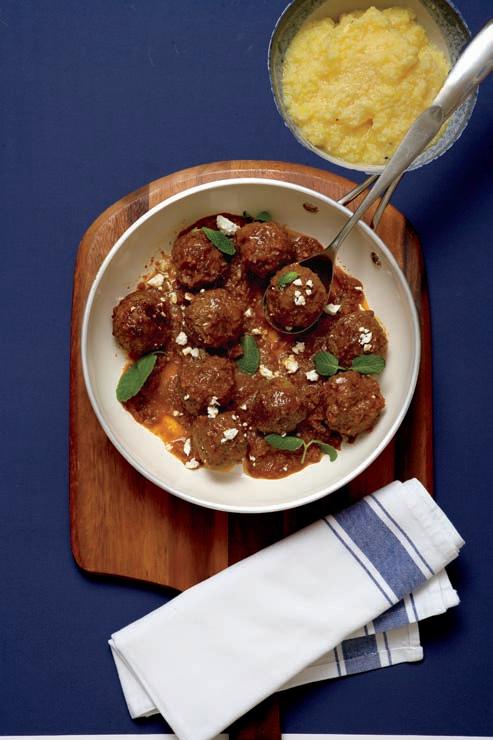
Stir together flour and salt in a large mixing bowl. Mix egg yolk, vinegar and enough cold water to make 1⁄2 cup. Cube lard into 1-inch pieces. Cut lard int o flour and salt mixture with a pastry cutter or two knives until the majority of the mixture is cut into pea-size amounts and resembles coarse oatmeal. Gradually add wet ingredients into flour and salt mix, mixing lightly with a fork. Once combined, gently press the dough into a large ball. Wrap in plastic wrap and refrigerate for at least 3 hours. For best results, freeze overnight then let thaw in the refrigerator (approx. 6 hours).
Filling
Mix melted butter and brown sugar. Add in egg, cream, vinegar and vanilla one ingredient at a time, mixing well after each addition.
Assembly
Once the fi lling is prepared and dough is chilled, cut dough in half and form into balls. On a well-floured surface, roll out one ball at a time until it is about an eighth of an inch thick. Using a large cookie cutter (the top of a glass may su ffice) cut out 12 circles of dough. If you run out of space for all 12 tarts, re-ball dough and roll out again. Place circles of dough into mu ffi n tins. Form lightly to the mould. The dough should meet the top of the tin or have a very slight overhang. Depending on the size of your mu ffi n tins, you may have to roll out your dough circles so that they are a bit larger. Make sure you do not roll it out too thin. You should have some folds around the edges when you fit the dough into the moulds. Drop in about 10 currants (or 5 raisins). Using a spoon , fi ll tart shells wit h fi lling no higher that half way. Bake at 350°F degrees for 25 minutes, checking on them at the 15-minute mark. Let cool. Should pop out easily with a knifeedge. Can be refrigerated for 5 days or put in the freezer for up to 3 months.
Pro Tip: If using the pastry for pie (or for tart dough), roll out between two sheets of plastic wrap to prevent sticking.
Meatballs
2 greens onions, chopped
2 egg yolks
1 slice bread, crust trimmed, torn into small pieces
¼ cup table cream
2 lbs ground lamb
1 tsp each fennel seeds and ground cumin
½ tsp cinnamon and sea salt
Toppings (optional)
Fresh mint
Crumbled feta
Oh yeah! Classic comfort food with a heated twist. A little spice and alotta big bold fl avour.
In a food processor, whirl the garlic cloves, with the chopped onion and grated fresh ginger until well chopped and almost puréed. Heat the vegetable oil in Dutch oven set over medium heat. Add cumin seeds. Heat until they start to sizzle, then add onion mixture. Stir often until mixture softens and is translucent. Reduce heat to medium-low to prevent browning, if needed. This may take 8 to 10 min.
Meanwhile, purée the canned plum tomatoes with the garam masala and turmeric, cayenne and salt. Pour into pan with onions. Stir in 1 cup water. Simmer 20 minutes to blend fl avours. If making ahead, cover and refrigerate up to 3 days or freeze up to 3 months.
For the meatballs, in a food processor whirl the chopped greens onions with egg yolks, small pieces torn bread and table cream until well puréed. Turn into a large bowl and add ground lamb, fennel seeds, ground cumin, cinnamon and sea salt. Gently mix until blended, then shape into balls: aim for a chubby golf ball size. Makes about 18 to 20 meatballs.
Space meatballs out on a baking sheet brushed with oil. Broil until browned, 6 to 8 minutes. Reduce heat to 375°F.
Add meatballs to sauce in Dutch oven. Cover and bake until sauce is bubbly and meatballs are cooked through, 10 to 15 minutes. Finish with fresh mint and crumbled feta, if you wish. Serves 4 to 6.
MICHAEL TOURIGNY
15
REBECCA WELLMAN
Recollections
TALES FROM TWO REBECCAS
REBECCA BAUGNIET
THE VERY FIRST ASSIGNMENT I ever had for EAT was a mini Buzz column. It was August 2009, and I had just applied for the Victoria Local Food Reporter position. It wasn’t an official assignment, it was the next step in the application process: write 300 words about what’s happening in Victoria’s food scene. What’s opening, what closed? I knew what I was aiming for – I’d been an avid EAT reader since arriving in Victoria one year earlier – I just wasn’t quite sure how t o fi nd it. I remember hopping on my bike, riding around downtown looking for new signs on shop fronts, then up Fort St. where I slipped quietly into that lovely food and cookbook emporium, Plenty, to eavesdrop on conversations, and fi nally home to my computer, where I scoured the internet for mentions of local food-related events and classes.
In the past nine years, I have refi ned the process. Thanks to EAT, I’ve made lots of food friends, found some sources - there’s a bit less eavesdropping involved now. But that sense of exploration and the excitement at spotting a new sign or even better - hearing about an opening before the sign has even gone up - has remained constant. I’ve learned I can’t trust my memory, especially for new names, so my phone’s photo album is full of images of little messages posted in restaurant windows and new awnings. For the past nine years my eyes and ears have been on high alert for all things food-related, and while part of my motivation was certainly to inform you, our readers, about what was new and exciting with food in Victoria, I’ve come to realize something else was driving me. I was always looking for something that would surprise Gary. If I cou ld fi nd something that even Gary hadn’t heard about yet, then I was doing a good job.
It was just a few days after I heard the sad news of Gary’s sudden death in early July that I biked past a newly opened restaurant. “I’ll have to let Gary know it’s open,” I thought, before the realization quickly followed that I couldn’t. Gary’s son, Colin, described a similar impulse when hearing a new song he thought his dad would like. This feeling will be familiar to anyone who has lost someone important in their lives With time, however, as you become more accustomed to the loss, the twinge of sadness that follows these moments lessens and instead they become a way to keep that person close by. I know that’s how it will be for me each time I see or hear about a new restaurant or new food event in town. It will conjure up Gary, and I will pause for a moment. Then I’l l fl ip open my laptop and write it down, as he would have wanted.
REBECCA WELLMAN
I FIRST MET GARY IN 2007, when in a bold move full of optimism, I contacted him about perhaps publishing some photos and words that I had written about the Tofi no Food and Wine Festival. We sat in Pure Vanilla at the end of June, perched on stools, drinking coffee and probably eating something sweet as we discussed the possibility of me working for him.
Over 11 years later, I am left with an abundance of fond memories of having joined Gary in creating 67 issues of EAT, 2 EAT Journals and 3 cookbooks. While as a younger photographer, I dreamt of contributing to Saveur, Bon Appetit and Food and Wine, it turned out that it was a little publication in Victoria, BC and a kind soul named Gary Hynes, that allowed me to build a robust portfolio, make incredible connections and build a career that has taken me much further than I’d ever imagined. Gary was known for giving beginners a chance. I really had no idea what I was doing when I fi rst started working for EAT, as I had never worked for such a publication and my ‘green-ness’ was glaringly obvious. How patient Gary must have been to take so many of us under his wing, and with quiet perseverance, nudge us in a direction that would contribute to success not only for EAT Magazine but for our own creative pursuits. Gary wasn’t harsh or critical. He didn’t break us down to build us up. He was quiet, observant, gently encouraging. If he really liked something he would say so with enthusiasm, and if he didn’t, he would often just not say anything at all. Honestly, I spent the fi rst 2 years at EAT Magazine, worried that he wou ld fi re me! It was always with a sigh of relief that I’d receive an email from him with the next set of assignments. Learning from him has reminded me to be conscious of those who are starting out. It has encouraged me to be patient, look for potential and to pay forward the chances that Gary so kindly gave to me. I can think of no better way to honour him than to continue to practice his way of being in this world.
Gary’s philosophy of quiet encouragement spilled over into EAT Magazine’s content. With never a harsh word toward any new establishment, Gary didn’t print bad reviews. Because of his familiarity with the culinary world, he knew that a bad review could ruin someone and it simply wasn’t in his nature to do that. I always admired and respected that about him. We are a small community, and Gary never forgot that.
I am incredibly grateful for Gary’s quiet mentorship; for all of his encouragement and his support over the years. When needed, he was there. He gave us freedom, yet despite his heavy multi-tasked workload, he always made time for us when we needed him to, without question or complaint. That was Gary. Stepping back to let us shine, stepping in when we required it. I am in awe of how he must have managed all of his contributors. I have hundreds of emails in my inbox from Gary Hynes and have recently enjoyed re-reading our light back-and-forth banter, tossing ideas around and talking about the city’s growing food scene. He kept us all included. He asked for our opinions. There was a lot of discussion. We were a team.

I sit here now, on the morning of Gary’s memorial service and I have many images of him in my mind. Gary at a media opening of a new place in town, that time I tried to quit EAT Magazine in 2013 and he (thankfully!) wouldn’t let me. Him sitting in the audience at my own book launch, across the table at a meeting, or art directing a photo shoot, his sarcastic sense of humour shining through as we worked on getting a shot just right. I always looked forward to those fun, creative experiences and I will never forget them.
I think for the next while, I will continue t o fi nd myself with my hands poised over my keyboard, ready to let him know what’s happening, or to tell him about a new recipe idea I’d like to try for the next issue or to ask him about his trend y fi ndings in his most recent trip to Montreal or Portland. I’m not sure how long it will take to get past this habit. 11 years is a long time, and there is a very poignant gap left. Rest in peace, Gary, knowing how much you have brought to so many over the years. I will miss you terribly.
Thank you for everything you did, Gary.
16 SEPTEMBER/OCTOBER 2018
REBECCA WELLMAN
WEST COAST ROAST
Serves 4
RECIPE, STYLING + PH OTOGRAPHY Rebecca Wellman
I CHOSE TO INCLUDE THIS RECIPE because it was one that Gary liked. And it was one that he challenged me on. Gary was always a bit more ‘meaty’ than I, and while I often veered towards a veg-rich dish, with Asia n fl avors or pickled things, he liked meat. Looking back at our email conversation about this, I voiced my reluctance, because cooking meat is not my strength. Gary expressed his encouragement and eventually won the battle. I developed and cooked the dish, and it turned out to be one of my very favorites. Thank you for pushing me to step outside of my comfort zone, Gary. This one is for you.
1 bone-in pork loin roast, frenched (about 3 pounds or 4 bones)
1 Tbsp Dijon mustard
1 tsp salt
½ tsp fresh ground pepper
1 Tbsp very fine bread crumbs
1½ tsp minced fresh garlic
1 Tbsp minced fresh thyme
1 Tbsp minced fresh rosemary
1 Tbsp minced fresh sage
1 tsp minced lemon zest
3 tsp olive oil
1 cup hard red wheat berries
2 cups chicken stock
2 bay leaves
¼ cup white wine
1 tsp salt
1 large shallot, finely minced ½ small fennel bulb, finely chopped (reserve fronds for garnish)
1 Tbsp lemon zest, minced
3 Tbsp olive oil
2 Tbsp lemon juice
1 Tbsp chopped chives
¼ cup chopped parsley
12 large prawns, roasted (BC Spot prawns are an excellent choice)
2 Tbsp butter, melted
1 Tbsp orange zest
1 Tbsp chopped chives
Salt and freshly ground pepper
Preheat oven to 375°F. Line a sheet pan with foil and set a rack on top. In a small bowl, combine Dijon, salt, pepper, bread crumbs, garlic, thyme, rosemary, sage, lemon zest and olive oil. Season pork generously with salt and pepper and transfer to prepared rack, bones up. Rub herb mixture all over pork roast. Cover each bone with foil. Let sit at room temperature for 30 minutes.
Spread wheat berries onto a sheet pan and bake, tossing occasionally, for 10-15 minutes, until fragrant. Set aside.
Increase oven to 425°F. Roast pork for 15 minutes, then turn down heat to 375°F and roast for another 60–70 minutes, until thermometer reads 145°F. Remove from oven, tent with foil and let stand for 15 minutes.
In the meantime, pour wheat berries into a large pot. Add the chicken stock, 1 cup of water, bay leaves, wine and salt. Cook for 50-60 minutes (time will depend on type and age of berries) until liquid is absorbed and the wheat berries are tender but chewy. Remove and discard bay leaves and drain any excess liquid.
Stir in shallots, fennel, lemon zest, olive oil, lemon juice, chives and parsley. Season with salt and pepper and set aside, covered to keep warm.
Mix roasted prawns, melted butter, orange zest and chives in a medium bowl. Season with salt and pepper.
Cut pork into 4 chops, leaving one bone in each. Spoon wheat berries onto 4 warm plates, top with pork and place 3 prawns on top of each. Garnish with reserved fennel fronds and serve with roasted broccolini.
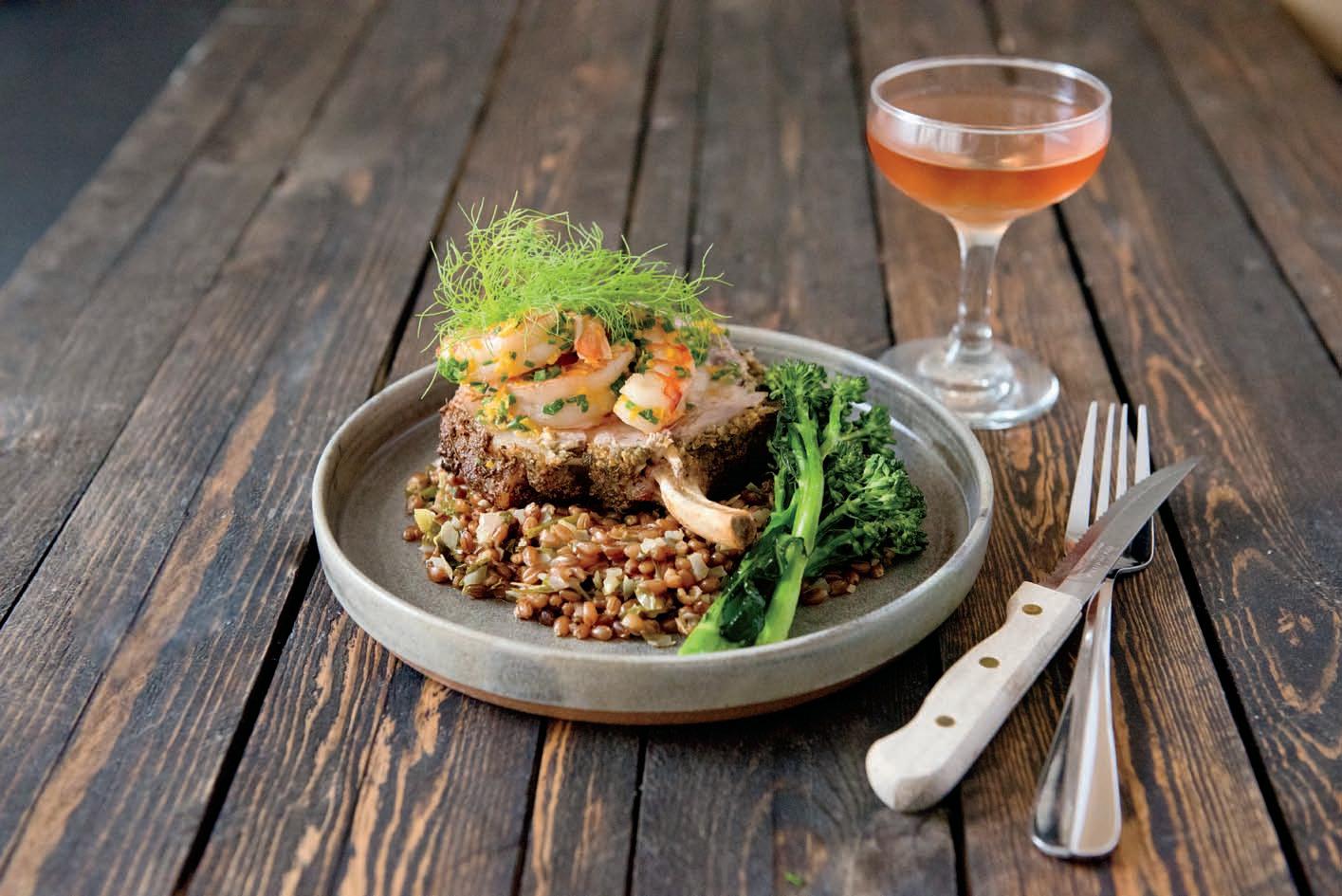
IN THE NOV/DEC 2017 ISSUE
PREVIOUSLY PUBLISHED
17
2032 OAK BAY AVENUE, VICTORIA 250.590.PORK











THEWHOLEBEAST.CA CURED@THEWHOLEBEAST.CA





Handmade Ethical Local Traditional
CURED AND SMOKED MEATS
18 SEPTEMBER/OCTOBER 2018
RISE OF THE FALL BEERS

Oktoberfest tradition and local innovation make this the perfect season for beer-lovers
TEXT: DANIEL MURPHY PHOTO: JOHANN VINCENT
It is late August as I write, and still hard to imagine that the dense rains of autumn will ever come – looking out at the muggy, smoke-veiled horizon – buildings made distant by the haze, like a thin sheet of gauze. Blistering wild fi res are greedily chewing up the province. The earth thirsts; everything crackles to the touch. But, as inevitable as sleep, the deluge will arrive soon enough. It will be a little sweeter, and a little less bitter an occurrence this year than usual – the pang of loss for our long, dusk-fi lled evenings will be tinged with relief for the cleansing rai n fi nally soaking hectares of smouldering ash, poking new, green cedar and hemlock up through the barren drabness. And, as they do at this time every year, our collective thirsts will migrate away from the quenching ‘lawn-mower’ genre of beer styles, to the slightly darker, richer offerings of the fall season.
We can’t, with any validity, discuss the beers that are on offer at this time of the year, without context. This is, after all, what every Bavarian, and most of the world at large, considers the climax of the beer-swilling year: for 16-18 days before the fi rst Sunday in October, Oktoberfest will stumble obnoxiously into Munich, relieve itself wherever it pleases, not remember how it got home, and spend the rest of the year getting over an uber-hangover and the taste of regurgitated pretzel. And then gladly do it all over again.
In 2017 the number of visitors to Munich’s official festival grounds was more than the total population of Libya, Finland or Singapore: a staggering (literally) 6.6 million. Somewhat disappointingly, the entire beer consumption was tallied at 7.5 million litres.
CONTINUED ON THE NEXT PAGE
19
MATT STANLEY, HEAD BREWER AT SPINNAKERS, ENJOYS A STEIN OF THEIR AUTUMN RELEASE: BLACK LAGER
BARRELLING ALONG with a rotating assortment of SMALL BATCHES





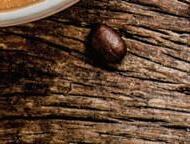



















CHECK BACK OFTEN to be certain that you DON’T MISS OUT stay in touch to find out more!

























SPINNAKERS BREWPUB. BREWING SINCE 1984 � 11 � 308 CATHERINE STREET. 2S0.386.2739. WWW.SPINNAKERS.COM U �



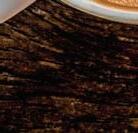


20 SEPTEMBER/OCTOBER 2018
That’s barely over a stein per person…confusingly responsible. But for all those millions of litres, only the following Munich-based breweries are permitted to contribute: Augustiner, Hacker-Pschorr, Löwenbräu, Paulaner, Spatenbräu and Staatliches HofbräuMünchen. These are the hallowed six who officially produce what has become known as Oktoberfestbier (a speci fic sub-genre of the Marzen beer-style.) Unsurprisingly, these beers are lagers (every German brewer’s true pride and joy), but not the pale-yellow, fl avour-challenged, Superbowl-advertised brews that you might associate with that word. The Oktoberfestbier varies somewhat in appearance – from very pale orange, through the amber spectrum to a light brown. Across these shades, the residual sugar should be higher than a light lager (or ‘Helles’ style), resulting in a medium bodied beer, with hints of demerara sugar, or lightly toasted bread, but not quite erring into sweetness on the palate. The fi nish should be dry and balanced - void of any lingering or cloying sensations. The restrained bitterness of the hops used should – as with all traditional German styles – only serve as a counterpoint to the malt richness, and should not be a focal point. The style from which it evolved its own personality – the Marzen – was traditionally brewed in March, towards the end of Germany’s legal brewing season, and cellared in underground caves through the warm summer, until the population grew restless for their late-September, post-harvest revelries.
Through trial-and-error, and now proven by scienti fic analysis, a slight increase in alcohol content and the amount of hops used in the brewing process produced a beer that better withstood the extending ageing period. We now know that these materials – alcohol and hops – contain identi fi able preservatives. This knowledge, for some unknown reason – perhaps an innate Bavarian sense of refi nement – did not push brewers down the ‘India Pale Ale’ (IPA) rabbit-hole like their North American counterparts, who use increased alcohol and hop content as a challenge to see who can force the highest dosage of each into a drinkable beverage.
Similar to this heavy-handed North American approach, autumnal brewing traditions have generally evolved into a di fferent animal on our continent. As consumers, our taste-buds also begin their annual yearning for the ‘comfort foods’ of beers – those with a stronger malt presence and a bit more ‘weight’ overall. But again, the Bavarian insistence on balance and subtlety gives way to a US/Canadian thirst for impact and intensity. In this vein, Spinnakers will release one of their multiple autumn seasonal offerings: their Black Lager. This moody, shadowy brew takes the Oktoberfest tradition of preparing darker lagers for fall celebrations and pushes it to “the extreme side of ‘roasty’” as per Head Brewer Matt Stanley. Expect strong roasted barley and unsweetened chocolate notes to dominate – the lager equivalent of a stout – but with a silken, cold-fermented smoothness and immediate ‘ fi nish’ on the palate. It is in line with Matt’s philosophy of fall brewing as a time for beers that are “not necessarily 6-pack beers, but sipping beers, sharing-with-friends beers.”
Across the Harbour at Swans’ Brewpub, Head Brewer Chris Lukie pays homage to the Bavarian spirit with an obscure variation on the Oktoberfestbier: a Flammenbeer. The addition of beechwood-smoked German malt to the grist imbues the fi nished product with a peaty, Single-Malt-Scotch-Whiskey-esque note. This is bolstered in Lukie’s rendition by sending crushed hops into the smoker at Oak Bay’s infamous ‘The Whole Beast’ salumeria before they are used in the brewing process. Hops treated this way add to the complexity of the smokiness – imagine hints of campfi re tinged with bacon, but just on the fringes of a cold, frosty amber lager. Perhaps a little challenging for the average Oktoberfest swiller, but not so for our local market: the Flammenbeer was voted Best in Show at the BC Beer Awards, 2017.
The importance and spectacle of the annual Oktoberfest celebrations cannot be denied. But in our part of the world, when the cool winds start to roll in off t he Juan de Fuca, taking the smoke-haze and scent of burning with them, our brewers look to the centuries-old traditions of European brewing culture, but with an eye for innovation, rather than observation; seeking The New; respecting tradition before experimenting the heck out of it. And I assume that most of us who inhabit this chunk of ground, removed and alone on the very edge of the continent, will gladly let those millions of revellers in Munich alone with their drunken commotion. There are more than enoug h fi ne breweries carving out new perspectives on this age-old season for us all to enjoy a personal Oktoberfest. I see no coincidence in the fact that as both the leaves and skies darken, so too do our brews – and, especially this year, we should embrace the gloom and wetness with full pint glasses.
please

performance may not be repeated and is not indicative of future results.

DO YOU CHECK WHAT GOES INTO YOUR INVESTMENT PORTFOLIO AS CAREFULLY? We believe that you don’t need to sacrifice your core values to meet your financial goals. You can be as selective about your investments as you are with your nutrition. www.blueherongroup.ca 250-361-2284 | blueheronadvisorygroup@cibc.ca Neil Chappell and Graham Isenegger are Investment Advisors and Portfolio Managers with the Blue Heron Advisory Group of CIBC Wood Gundy in Victoria BC. CIBC Wood Gundy is a division of CIBC World Markets Inc., a subsidiary of CIBC and a Member of the Canadian Investor Protection Fund and Investment Industry Regulatory Organization of Canada. CIBC Private Wealth Management consists of services provided by CIBC and certain of its subsidiaries, including CIBC Wood Gundy, a division of CIBC World Markets Inc. “CIBC Private Wealth Management” is a registered trademark of CIBC, used under license.
Gundy” is a registered trademark of CIBC World Markets Inc. If you are
a CIBC Wood Gundy client,
your Investment Advisor. Past
“Wood
currently
contact
As both the leaves and skies darken, so too do our brews.
21
—DANIEL MURPHY
A FRESH FOOD VIBE IN THE FRASER VALLEY
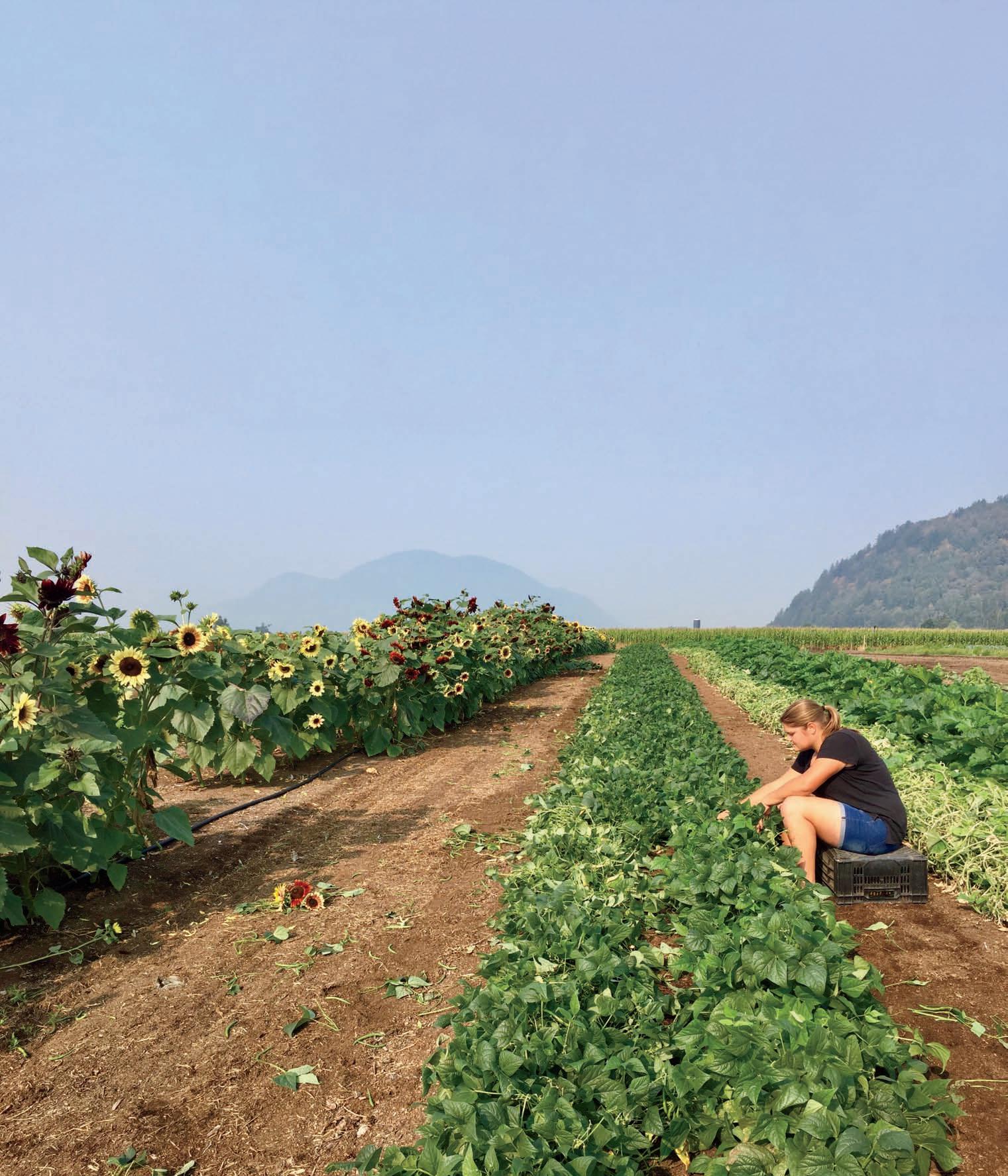
TEXT AND PHOTOGRAPHY: CINDA CHAVICH
IT’S THURSDAY AFTERNOON IN ABBOTSFORD, and a long lineup is already forming outside the Field House Brewery
But it’s not just the usual beer geeks, here to taste their small batch whisky-infused sours and effervescent Champagne yeast experiments. There are couples and girlfriend groups, seniors and young families with toddlers.
The Field House has become a community hub, where locals gather to meet, eat and enjoy local musicians who take to the stage, coffeehouse style, on the front lawn. There’s a chef ensconced in a tiny taco shack in the parking lot turning out tortillas topped with Yarrow Duck Con fit and cracklings, braised beans and avocado mousse, and pizza from the wood-fi red oven. Groups gather at picnic tables on the covered patio to nosh, serious tasters take a seat at the bar, others lounge in webbed red lawn chairs in the sunshine.
Chef Bonnie Friesen has curated a kitchen fi lled with farm-fresh Fraser Valley ingredients – like her Faspa board of local cheese, charcuterie and house-made pickles – while the brewers are busy turning out a wide array of eclectic ales, from the refreshing dry-hopped Medusa Lime Sour to the Chardonnay Farmhouse, fermented with grape juice and infused with elder flowers.
AT THE HARVEST MARKET AND ORGANIC FARM NEAR CHILLIWACK, FAMILY MEMBERS LIKE JULIE OOSTENBRINK PICK FRESH PRODUCE DAILY.
Presiding over it all is owner, publican and local food advocate Josh Vanderheide.

“With lots of young families, we needed an authentic gathering place that welcomed everyone,” he says of his vision for both the brewery and a new community food hub.
“We’re here to build community, and beer is how we’re doing it.”
Like many of the young entrepreneurs who are energizing Abbotsford and it s fledgling food scene, Vanderheide grew up in the Fraser Valley, left to start his career, and was drawn back home to raise a family. What began with a craft brewery in 2016 has grown to include a network of small farms growing “all of the inputs” for his operation, including the fi rst malting barley in the region. Field House Brewing is also the local poster child for melding business and community, and ground zero for his goal to “make the valley a global food destination.”
“We need to identify what is our ‘food culture’ in the Fraser Valley,” explains Vanderheide, delivering a plate of crispy potatoes fried in duck fat with verdant thyme and IPA aioli, and a bowl of Brown Butter Chilliwack Popcorn.
“This is important. We won’t have a local food culture unless we step up to the plate and are part of this process.”

BUILDING A FOOD HUB
While other communities have tried – and failed – to develop local food hubs, the impetus is always the same. Keen chefs, farmers, and foodies want to make connections between local food producers and consumers, promote local agriculture and ensure it’s sustainable and accessible to all.
But even in the heart of the Fraser Valley – where agriculture is king – there’s a gap between what’s being produced and what’s available to local consumers and chefs.

When a group of food advocates in Abbotsford decided it was time to change that, it wasn’t long before their Valley Food and Farm Collective (VFF) was born. The VFF held it s fi rst public meet in October of 2017 and by July had launched the non-profit VFF and Rail District Community Market in a permanent location on the edge of the historic downtown district.
“We are surrounded by farms, the largest food production region in the country,” says Vanderheide, “but we needed to bring the farm into the city, to shift that logistical piece.”
The fi rst donations of cash for the VFF food hub came from Vanderheide, the In fi nity Group (a residential real estate developer) and a variety of other stakeholders, including the University of the Fraser Valley, Tourism Abbotsford, local farmers, restaurant owners and individuals.
The collective now has 150 members and has raised more than $60,000 to launch the project. An old Bucker field’s
store that had stood empty for fi ve years is being repurposed as an indoor farmer’s market, commissary kitchen, café, education and offices spaces for rent. Plans include a local certi fication program and logo to identify Fraser Valley food products and restaurant menus.
VFF Executive Director Kathleen Robinson says because the Fraser Valley is already a major food-producing region, there’s a strong agricultural infrastructure and plenty of academic research to support the non-profit initiative. Locals are keen to develop an identity for their city and their region, and “stepped up and supported it on blind faith,” she says, with donations, raised through networking, email campaigns and fund-raising events.
“It’s also about having young entrepreneurs pushing a community project, a bunch of community-minded people working together.”
ABBOTSFORD UPDATED
The food hub market sits next to the old Abbotsford rail line in East Abby, near Field House Brewery and a handful of other new eateries. It’s on the edge of historic downtown Abbotsford which has seen its own renaissance in recent years, thanks to Algra Bros. Developments, a local company that purchased several old buildings, restored them, and set about curating the kind of tenants that have made it an exciting new destination.
Where ageing enterprises once stood, there are now coffee shops, bookstores, bakeries, restaurants and boutiques, all with a youthful, modern vibe.
The hip Oldhand Coffee was one of the fi rst businesses to move back into Abbotsford’s downtown. Like many of the young entrepreneurs here, Kristina and Johannes van Vloten are among the economic/housing migrants who have left larger cities and returned to their Fraser Valley roots.
“We lived in Victoria and Vancouver for 10 years,” says Kristina, describing their careers in the artisanal coffee
industry. “We fell in love with the culture of exceptional coffee and wanted to bring it home.”
Other small businesses – The Habit Project fresh juices, The Polly Fox gluten-free bakery, Confetti Floral and Blueberry Meadows furniture – were offered move-in ready real estate to kick-start the renewal.
“It was the developers having a vision and helping us create this beautiful space – we could not have managed it on our own,” says van Vloten.
On nearby Montrose Avenue, you’l l fi nd snoop-worthy shopping at The Spruce Collective and Yes Chef , a wellstocked kitchen store. Chef Tyler Duft and his pastry chef wife Cassandra Crocco have opened two destinations for food lovers – the Duft & Co. Bakehouse artisan bakery and Brickhouse wood-fi red pizzeria across the street.
“This used to be a ghost town, but we were part of the renaissance when we opened the bakery in 2014,” says Duft. The couple returned to Abbotsford from Vancouver, where Crocco honed her pastry skills at Thierry and is now renowned for her croissants, focaccia and doughnuts. She also makes the big peanut butter sandwich cookies they serve at Brickhouse where the lineup for pizza snakes out the door.
Even with two young children and their bustling new coffee house, the van Vloten’s have another new baby on the way – their Little Brother brunch and lunch spot opens soon. They’ve lured chef Spencer Croteau back to the Fraser Valley from Edmonton (Duchess Bakery) as a partner in the new eatery. Like them, he’s excited about the future of valley cuisine.
“This is where so much of our food comes from, and the fresh ingredients are incredible,” he says, “I like the Fraser Valley – it’s like coming back home.” CONTINUED
ON THE NEXT PAGE
PIZZA AT DUFT & CO IN ABBOTSFORD
23
THE LOCAL FRASER VALLEY CHEESE AND CHARCUTERIE WAS PART OF THE CULTIVATE DINNER, CHEF BONNIE FRIESEN PREPARED THE DISPLAY
Made You Look
LOVELY LANGLEY AND THE WACK
There’s a growing food scene in Langley and Chilliwack, too.
A tour of Fort Langley’s national historic site uncovers the deep roots of agriculture in the valley, where the Hudson’s Bay Company once grew and shipped enough food to supply it’s trading posts across the province. It’s also where the indigenous Kwantlen people traded wild cranberries and salmon with the HBC - salted salmon becoming more profitable than fur trading here.
The Kwantlen First Nation continues to feed the fort today, with its lelem’ Café at the historic site, and the larger lelem’ Arts & Cultural Cafe in the heart of town. Here you’l l fi nd “comfort food with an indigenous twist,” says Rocky Nenka, serving up bannock with sweet cedar butter, a Salish Sea breakfast sandwich with smoked salmon, elk stew and venison sliders with elderberry jam.
At Sabà Cafe & Bistro Simone Hurwitz and Enrico Campani, with their three lovely daughters, have created a lively bakery and eatery with a farm-to-table ethos that reflects their Mediterranean roots. The dining area spills into a sunny courtyard and the rustic, seasonal menu, from breakfast shakshuka or braised short rib hash to gorgeous baking and excellent coffee, makes it a popular local gathering place.
“We want this to be like a little piece of Italy, a place where people can come to eat and talk,” says Hurwitz who moved her catering business to Langley from White Rock.

Trading Post Brewing has a new taphouse in Fort Langley with burgers featuring local Chilliwack’s 63 Acres beef. Little Donkey is the place for burritos and beer.
There’s a decidedly urbane vibe – and upscale menu – at former Vancouver chef Romy Prasad’s Fortitude Restaurant .
Downtown Chilliwack (a.k.a. The Wack) is poised for an Algra Brothers restoration, too, but there are already reasons to visit. The 1909 Royal Hotel offers quirky accommodations and local food in a historic space, from the Wellington Local House to The Doughnut Hole, with a crazy collection of handmade, decadent doughnuts.
Nearby, there’s locally inspired breakfast and lunch fare at Harvest Store & Cafe, with in-house baking and comfort food, from doughnuts and lemon blueberry pancakes to vegetarian chili, and creative grilled cheese sandwiches.
FRASER VALLEY FOOD TOURING


Beyond these small cities, meandering down the valley back roads makes a tasty a scavenger hunt for foodies.
Look to the excellent Circle Farm Tour routes (both maps/pamphlets and website) to taste and fi ll








250 598 8555 | marinarestaurant.com | 1327 Beach Drive
LELEM’ CAFE IN FORT LANGLEY CEDAR INFUSED BASIL ARTICHOKE BRUSCHETTA
24 SEPTEMBER/OCTOBER 2018
TRACTOR AT TAVES FAMILY FARM
the cooler at local farms, markets, wineries, cideries, cheese makers and other agri-tourism destinations. Or grab a copy of Angie Quaale’s new cookbook (and guide), Eating Local in the Fraser Valley (Appetite by Random House).

Taves Family Farm outside Abbotsford has U-pick apples, hay rides, and freshly pressed cider. Campbell’s Gold Honey Farm and Meadery is the place to learn all about the fascinating life of honeybees, from a family of passionate experts, and buy honey and mead (honey wine).
At Tanglebank Gardens, a garden centre and bistro, the brunch is legendary, and Lepp Farm Market sells local fruits, vegetables, meats and other Fraser Valley food.

Drive the beautiful road to Mt. Lehman Winery – and taste their award-winning Pinot Noir – then head to Singletree Winery for their aromatic Gruner Veltliner and Siegerrebe.
BC Hop Co. is reviving the onc e flourishing Fraser Valley hop industry, processing hops for local growers and showcasing fresh, wet hop beer from 40 craft brewers at the annual BC Hop Fest on Sept. 29, 2018.
Outside Langley, there’s the lovely Fraser Valley Cider Co. – a perfect place to gather with locals on the patio and sip dry, English-style ciders. Visit wineries like Chaberton Estate Winery and Backyard Vineyards, and try the artisan spirits at Roots and Wings Distillery – vodka, gin and whiskey crafted from potatoes and corn grown on their family farm, and available for sale their new tasting room.
Handcrafted goat milk cheeses – and yummy goat milk gelato – are sold from the pretty shop at Milner Valley Cheese, where you’ll also see their handsome herd frolicking in the field.
Beyond Chilliwack, there’s Chilliwack
Corn Maze & Pumpkin Farm (home to the Bruinsma sisters’ elegant annual Cultivate long table dinner, celebrating the fi nest Fraser Valley food producers), while this season’s inaugural Chilliwack Sun flower Festival is a great place for photo ops among 12-foot flowers.
If you’re after amazing organic vegetables – and freshly-mille d flour for your baking projects - don’t miss The Local Harvest Market where Dan and Helen Oostenbrink, and their industrious young family, grow a delicious array of organic vegetables to sell in their new farm store. They’ve also teamed up with Anita’s Organic Flour Mill , offering a vast selection of the local miller’s flours, mixes and other baking products. Son Dustin uses these organic flours for the beautiful pies, bagels, breads and pizza he bakes in the woodfi red oven on the farm.
Taste the range of craft brews at Old Yale Brewing Co. - don’t miss their famed Sasquatch Stout.
STAY AND PLAY
The Brookside Inn, on the rural edge of Abbotsford, makes the perfect base for your valley agri-tourism adventure. The comfortable boutique hotel has six suites, each eclectically decorated i n a fi lm or literary theme, with sumptuous breakfasts from the chef/owner’s kitchen and garden. Ask about their guided farm, wine and beer tours, too. www.brooksideinnabbotsford.com
25
DUSTIN OOSTERBRINK BAKING BAGELS
SWEET SIMPLICITY
TEXT: JENN DANTER
PHOTOS: JACQUELINE DOWNEY
What I remember fondly about Gary is that he could sit down t o a fin e dining meal, or pick up a ripe apple and appreciate the genius and beauty of both. With the crisp notes of fall in the air, I think he would’ve liked to eat this.


26 SEPTEMBER/OCTOBER 2018
APPLE-CRANBERRY DUTCH BABY

Serves 4
3 eggs
⅔ cup milk
⅔ cup all-purpose flour
3 Tbsp brown sugar
¼ tsp sea salt
¾ cup fresh or frozen (defrosted) cranberries
3 Tbsp unsalted butter
Maple-Thyme Bourbon Apples (recipe below)
Whipped cream or Skyr (optional)
Preheat oven to 425°F. In a blender, combine eggs, milk , flour, sugar and salt.
Heat a 10” cast-iron frying pan over medium-high until hot. Add butter; swirl in pan until bubbly. Pour in batter. Sprinkle cranberries over top.
Bake until pu ff y and golden, 15-18 min.
Top with Maple-Thyme Bourbon Apples and a dollop of whipped cream or Skyr.
Tip: Skyr is sold as Icelandic yoghurt. Rich in protein, it has an uber thick texture (makes Greek yoghurt look positively runny) and rich, tang y fl avour. Mix with whipped cream to be really decadent!
Maple-Thyme Bourbon Apples

3 unpeeled apples, such as Macs, Granny Smith or Ambrosia
½ tsp cinnamon
Pinch of sea salt
2 Tbsp butter
Handful fresh thyme springs
3 tbsp Bourbon
Maple Syrup, to taste
Cut and core apples; thickly slice. Sprinkle with cinnamon and salt; mix to coat.
Melt butter in a large frying pan over medium-high heat. Add apples and thyme; sauté until lightly browned, 2 min.
Pour in bourbon; scrape up and stir in any brown bits from pan bottom. Turn into a Mason jar or bowl; top up with warm maple syrup.
Refrigerate any leftovers up to 5 days.
27
Rue Notre-Dames, Montréal
THE AUTONOMOUS REGION OF LITTLE BURGUNDY, SAINT-HENRI AND GRIFFINTOWN IS BUILT

ON RELATIONSHIPS AND HISTORY
Photography: André Rozon
Words: Gary Hynes
Last fal l I flew to Montréal to visit the areas of Little Burgundy, Gri ffi ntown, and Saint-Henri in the historic neighbourhood that surrounds the Rue Notre-Dame strip. This fast developing and exciting borough stretches out along the east-west artery that slices through the southwestern portion of Montréal along side the Lachine Canal. It’s close to Montréal’s downtown, but separate and distinct.
You can’t talk about this neighbourhood without talking about Joe Beef—a world-famous restaurant that made this area what it is today. Opened in 2005, they were part of the makeover of this entire area. They have Little Burgundy and Gri ffi ntown stamped on their hearts. They even have their beer made just down the street in Saint-Henri at the microbrewery Bierbrier (from a recipe they found for how beer was made in Little Burgundy a long time ago). Fifty years ago, the area was working class, cold-wat er fl ats, jazz clubs, and gun-toting gangs. Joe Beef helped remake an area that was once rough and troubled and opened it up for others to follow.
Today the area i s fi lled with new restaurants, bakeries, and condos going up seemingly everywhere. Hoards of professionals have moved into the area; good news for the shopkeepers and chefs who are fi nding that their stores, restaurants and cafés are busy—especially in summer when the terrasses and outdoor patios are crowded to capacity. It’s a neighbourhood where you’l l fi nd good food, and friendly patrons.
Take a walk with me, meet the chefs, and explore the new restaurants and bakeries that hug the sidewalks of Rue Notre-Dame.
Travel assistance was provided by Tourism Montréal. The writer and photographer stayed as guests of the newly renovated Fairmont Queen Elizabeth (fairmont.com/queen-elizabeth-montreal and the contemporary ALT hotel in Griffi ntown (althotels.com).
TRAVEL
28 SEPTEMBER/OCTOBER 2018
ATWATER MARKET, BUILT IN 1933, IS KNOWN FOR ITS MANY BUTCHERS AND FROMAGERIES. CHEFS DROP BY IN THE MORNING TO SEE WHAT’S FRESH THAT DAY. CHEF JEAN-PHILIPPE TEES OF HVOR RESTAURANT SAYS, “THIS WHOLE AREA HAS A FOCUS ON LOCALLY SOURCED PRODUCTS WHATEVER IT MAY BE – FOOD FOR US, BEER, WINES – THERE ARE SO MANY LITTLE SHOPS THAT ITS A GREAT INSPIRATION.”
HVOR restaurant
“ I’ve lived in a lot of places in Canada. When I wanted to learn about seafood I went to Newfoundland, for culture I went to Nunivak. I wanted to learn about wild game so I went to Alberta. It’s always about using the best, freshest ingredients possible and not limiting ourselves to a style of cooking. You may come to HVOR one week and it’s more Italian-based. The next week it will be French-based. Or another time it will be anything and everything. We cook the ingredients in the way they are deserved to be cooked and are the most passionate about.
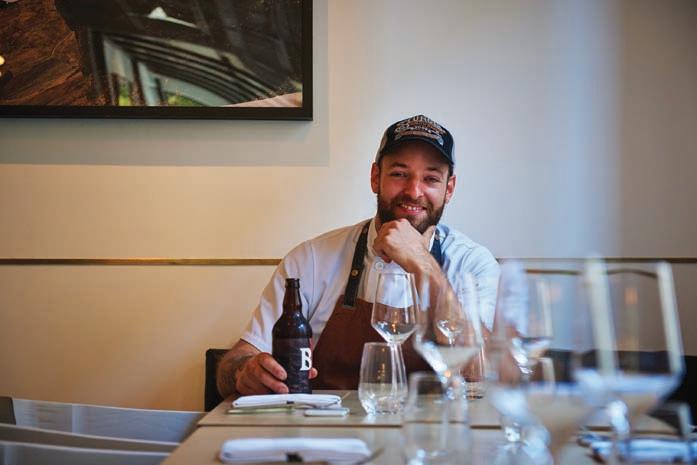
I’m in fluenced by the North. I’ve come to appreciate gravlaxing as more than a holiday tradition, I’ve come to see it as a preserving technique. I depend on pickling and fermentation. When I fi rst started it was the new craze in cooking. Instead of adding powders and changing the whole DNA of it. I’ve always explained fermentation as when you’re young you know about onions – cooked or raw then later on you caramelize that onion – you’ve unpeeled another layer of fl avor. That you didn’t know was there but it’s still the same onion it’s just treated another di fferent way. I see fermentation and pickling as the same thing, you’re working with the ingredient itself and releasing more layers of the fl avor that were hidden underneath that was always there. Living up north realizing if you want to eat tomatoes in February you have to can them. Or pickle carrots if you want them to last all winter. It brings a sense of urgency and respect to our trade. I had to leave the city centres in order to relearn those traditions and fall in love with the olden ways of doing things.”
CHEF JEAN-PHILLIP TEES
Takeaway: Cool modern, northern vibe, changing menu, focus on fermentations.



1414 rue Notre-Dame Oues Montréal 514- 937-2001 hvor.ca
PICTURED ABOVE: CHARCOAL GRILLED, DRY-AGED QUEBEC RED DEER WITH DEHYDRATED, HONEY-ROASTED CARROT, BLACK GARLIC PURÉE, BLACKBERRY, GEL AND FLEUR DE SEL PICTURED BELOW: BLACK PEPPER, CARDAMOM ALMOND CRISPS WITH WHITE CHOCOLATE POWDER,TAPIOCA AND CRANBERRY
29
LE RICHMOND restaurant

“ Le Richmond opened in the fall of 2013. The building originally housed a club and rave house. Current owner Luc Laroche is a fashion designer and he designed the restaurant and the attached market that now occupies the space.


The area has completely changed from 10 years ago with younger families and professionals moving in. There are new restaurants and new shops, condos and high-rises—money everywhere. But at the same time, you still have the old buildings, the same streets, and the canal. You can see the downtown skyscrapers from here.
We are a farm-fresh, northern Italian dining room in a swanky, retrofitted industrial space with vintage elements. The food here is comforting and elegant. At the same time, it’s industrial chic. I just came back from Italy where I did a stage at Mare. They taught me many things, including the dish we’re making for EAT.
Our food is comforting, you can have dinner here and then go next door to our Marché Italien Le Richmond and pick up the ingredients to take home. On Thursdays, it’s a 30s crowd with a DJ and more of a supper club feel. Sundays we have a brunch that extends into the evening.”
 CHEF LIAM FANNING
CHEF LIAM FANNING
Takeaway: Design-focussed, lively, Italian
377 ave Richmond Montréal 514-508-8749 lerichmond.com
PICTURED ABOVE: RICOTTA CAPPELLETTI WITH BURRATA, SUMMER TRUFFLES, PEA, UMBRIAN SHOOTS, LEMON, EMULSIFIED CHICKEN STOCK.
30 SEPTEMBER/OCTOBER 2018
CANDIDE restaurant
551 rue Saint-Martin, Montréal, in the former rectory and Sunday school of the St. Joseph’s Church now known as Project Salon 1861 514-447-2717 restaurantcandide.com
“Candide is the fi rst restaurant I’ve owned, but not the fi rst restaurant I’ve run. When I was explaining the concept of the restaurant to my friends and colleagues in the industry, I said I’m very set on regional and seasonal products, and they would say it sounds much more like a country restaurant. You go to a particular place, to a country restaurant, and they have the cheeses from around there, they have the vegetables from around there and the meat from around there; then my business partner found this place, which is in the city, but it’s in the country, it’s not really on a road, it’s between two parks. The city kind of falls away in the thirty metres it takes to get you to the front door from the street. That struck me as making so much sense for the type of restaurant we were trying to do. Also, it had fantastic potential for the outdoor eating space and patio. In most of Montréal, there are a lot of really nice terraces, but the majority of them are on the street—right on the curb. Here you feel as if you are in the middle of nowhere and when the lights go down you are in the middle of the country. It very calm and serene and it matched very well with what I was trying to express.
All the food we cook with here comes directly from the producer; there are very few distributors involved. The few distributors we have work as co-op distributors—one farmer will distribute his produce plus that all of his neighbours’ produce. But it’s not what I think of as the restaurant’s selling point. It expresses what’s around me, what people grow, what people raise, the products people make. My job is to get them in and not screw them up. It’s delicious whether it’s in a French- or an Italian- or Vietnamese-style. You can do it with what’s around here; you just have to adapt to what you have. You could call it farm-to-table, but I’m not a geek, so the idea is to just create a delicious menu and put on display everything produced around us. I didn’t want to have a gigantic menu – it had to be a small menu. I wanted the kitchen to take the plates out a s I fi nd that more indicative of teamwork. We want the guests eating and enjoying themselves.” CHEF
Takeaway: Calm oasis, serene, farm-to-table.

 JOHN WINTER-RUSSELL
JOHN WINTER-RUSSELL
PICTURED ABOVE: GUINEA FOWL GRILLED OVER CHARCOAL, WITH GRILLED RED PEPPER SAUCE, SWEET HABERERNOS AND EDAMAME

PICTURED BELOW: GRILLED ZUCCHINI, SICILIAN SQUASH TENDRIL SLIGHTLY GRILLED, SAUCE IS CONFIT AND PICKLED GARLIC, LOMO MADE IN HOUSE

31
FOXY restaurant
“The food that we do here dictates that we work wit h fi re and most of the inspiration comes from that fact. I had to relearn how to cook when I started working here. There’s a whole bunch of classic techniques that we can’t use anymore. Boiling water in this restaurant is an ordeal. We only us e fi re. Our style is very smoky, fresh, and vibrant.
The way we work the creative process is it’s a signi ficant team effort. There’s Leigh Roper (ex Vin Papillon) and Vanessa who come up with most of the creations as well as the owners, Dyan Solomon and Éric Girard, who are also the owners of Olive+Gourmando which has been open for 18 years in the Old Port. Before opening Foxy, Dyan and Éric travelled to Argentina to learn about and taste the food produced using the art of wood-fi re cooking with Chef Frances Mallmann. Compared to most of the other kitchens I’ve worked in, it’s very collaborative. I think everyone’s personality shows up in the food. We’re well past the years of angry, yelling chefs. Good vibes and respectfulness are important.
I live in Pointe-Saint-Charles, right across the Lachine canal. Gri ffi ntown is blowing up with all the condos around the canal; there are all the bike paths, and people are out walking around—especially in the summer. We’re open on Sunday and Monday because most the neighbourhood restaurants are closed. We also get all the cooks and servers from the area when they aren’t working.
We always have rib steaks on the menu. We get our beef from a farm called Ferme du Nordest. The Angus cows are raised humanely without hormones, and the fi fth generation farmers grow their own barley, wheat and oats on the 1,200-acre ancestral farmland for their cattle. We dry-age the rib steaks for a month in-house and cook them on the wood grill. Right now the steaks are being served with roasted Roma tomato butter, seasoned with garlic and thyme. On the side is grilled corn, aioli, Parmesan cheese, Espelette, lime juice and lime zest. We use the wood-fi red oven for everything. It never goes below 350°F degrees, so we try and use it during the daytime, too.”
CHEF SEBASTIAN CHAMBERLAND

Takeaway: Warm, comforting and romantic restaurant with clean flavours, vibrant colours, great ingredients, and balanced textures. The smoky smells bring conviviality. In the winter, you smell like a campfire when you go home.



1638 Notre-Dame St W Montréal 514-925-7007 foxy.restaurant
PICTURED ABOVE: 24 HOUR CREAMY FETA MADE IN-HOUSE, PASTURED FARM EGGS,CUCUMBER, RADISH WITH A BUTTERMILK DRESSING PICTURED BELOW: THE BLACK DOG BOURBON, AMARO, 2 TYPES OF VERMOUTH, FERNET BRANCA
32 SEPTEMBER/OCTOBER 2018
PERLES ET PADDOCK restaurant
“I’ve worked at Au Pied de Cochon, Toqué! and Restaurant Park in Montréal. I spent seven years in Hong Kong including a stint at a Gordon Ramsay restaurant. A mentor was Shinya Maeda, the chef at the Gordon Ramsay’s Tokyo restaurant. I learned how to be a real cook –to be consistent, be professional and have a good work ethic. Shinya never took a day off . He tasted everything we made. I left alone and came back with a wife and kid. My wife is a pastry chef at the Ritz Carlton. My parents live in Montréal. In Montréal we don’t have many pastry chef positions left. I live in this area – 5 minutes away in Saint-Henri. It’s changed a lot in the pas t fi ve years. Before it was a poor area.

Perles et Paddock Restaurant opened in June, 2017. The owners are Maxime Perrault and Jessica Goulet. Maxime’s father ran a bar but Maxime wanted something more. He came up with the design concept. It was a garage before and before that a stable or paddock, of which there were many in the area. The restaurant is divided into several spaces with di fferent atmospheres that separate the place in an organic way. The materials used, the plants and the lighting make everything chic and elegant. Perles and Paddock offers 16 lines of draft beer and an extensive cocktail menu - as well as a dining room portion - which offers a seven-course tasting menu. There are bright white walls, tan faux leather chairs, assorted light fi xtures, a communal table in the back and potted plants galore. There’s a tree in the middle of the room and a cool painting of a calèche horse behind the bar. Our food is what I call nourishing gastronomy: light, fresh and sustainable.” CHEF PADDY CHEANG

Takeaway: Trendy, stylish, minimalist chic, instagram-able, fresh, live, sustainable, 14 top beers.
PICTURED ABOVE: TOMATO THAT’S BEEN MARINATED IN PAT CHUN (SWEETENED VINEGAR) WITH PICKLED PEARL ONION, CANTALOUPE, THAI BASIL, AND TOMATO ESSENCE.

PICTURED BELOW: HAMACHI TUNA, WATERMELON RAVIOLI, FINGERLIME GINGER VINAIGRETTE

403 Rue des Seigneurs Montréal 514-931-0004 perlesetpaddock.com
33
LE FANTÔME restaurant
“ “I have lived in Saint-Henri for eight years. Our style is not giving a f***. We cook what we want to cook—that’s the bottom line. We change the menu as often as we get bored of the old one. It very much depends on my mood. We try and use products that are available to use locally, but if I ca n fi nd a better product that’s not local, I’ll buy that. Quality trumps local. There are no peaches grown in Quebec, so I’m not not going to o ff er peaches.

Lately, we had a fi sherman from Gaspé come in with three line caught tunas. We were lucky enough to get fi rst dibs on the heads. We can’t necessarily a fford to buy all the toro or the whole tuna—but we do buy a little bit of toro. We’ve been using the necks and forehead of the tuna—exciting for every cook here to work with. Turning that into a tartare with some horseradish cream and pu ffed beef tendon. Steam it for 4 hours, slice it thin, dry it for another 5 – 8 hours and then you fry it. The collagen and tendon keep it together. Same process as popcorn. A little bit of moisture is still left inside, and when it expands, it pu ff s. Like pork chicharrón, but with beef.
Matsutake mushrooms came in yesterday—we try and get the ones that are still closed— they’re super-perfumed. We marinate them in pine shoots collected and dried in the spring, and we’re going to make a pine oil with a little bit of shallot and kiss them on the grill. We’re serving them with Atlantic halibut (I randomly get a call from the fi shing boat, and you’ve got to say yes to whatever they have, or they won’t call you next time).”
CHEF JASON MORRIS
Takeaway: Serious, 8-12 course tasting menus, juice pairings, make their own tonic with elderberr y flowers, a focus on details and service, intimate setting with a dim, candlelit atmosphere.



1832 rue William
Montréal 514-846-1832 restofantome.ca
PICTURED ABOVE: VEAL BREAST, QUAIL EGG, MOREL GLACÉ IN BONE MARROW, EGG YOLK COOKED IN BONE MARROW FAT, POLENTA, AND VEAL SWEETBREADS GLAZED IN VEAL JUS WITH COCOA NIBS ON TOP.
34 SEPTEMBER/OCTOBER 2018
PATRICE PÂTISSIER bakery, café
“ Before opening the shop, I worked at a few well-known Montréal restaurants such as Laloux (working with Marc-André Jetté and Marie-Josée Beaudoin), Lemeac, and 400 Coups, one of the best restaurants in the city. I had seen how successful Joe Beef was in opening up in Little Burgundy and I found a storefront on Notre-Dames just east of Joe Beef. My idea was to do a combined pastry shop and café and work with small, seasonal producers and foragers. You could say my style is to create fresh and seasonal desserts where fruit and acidity play an important role and where sugar never dominates.

I live in the area as my customers do. Part of my daily ritual is to go to Atwater Market every morning to see what’s fresh. All unsold desserts at the end of each day are packed up and donated to a neighbourhood organization, Let’s Share Hope, to eliminate food waste. I give to the food bank as I feel it’s important to give back to the community.
Some favourites of mine are the éclair made with apple, bay leaves and honey (we get buckwheat honey locally at Miels d’Anicet’s Honey Farm) and the lemon tart made with lemon and lime yazu and tarragon.
Besides our pastries, which you can get at any time of the day, we do lunch in our café and serve soups, salads, sandwiches, and tartares. One of the most popular desserts is called Le Vert with green apples, pistachios, olive Oil, cilantro granita, and creamy white chocolate yogurt.”
CHEF
PATRICE DEMERS
Takeaway: Pastry paradise, organic, takeout and sit down.
Story previously published in The EAT 2018 Collector’s Edition and the last major story Gary Hynes wrote for his publication.
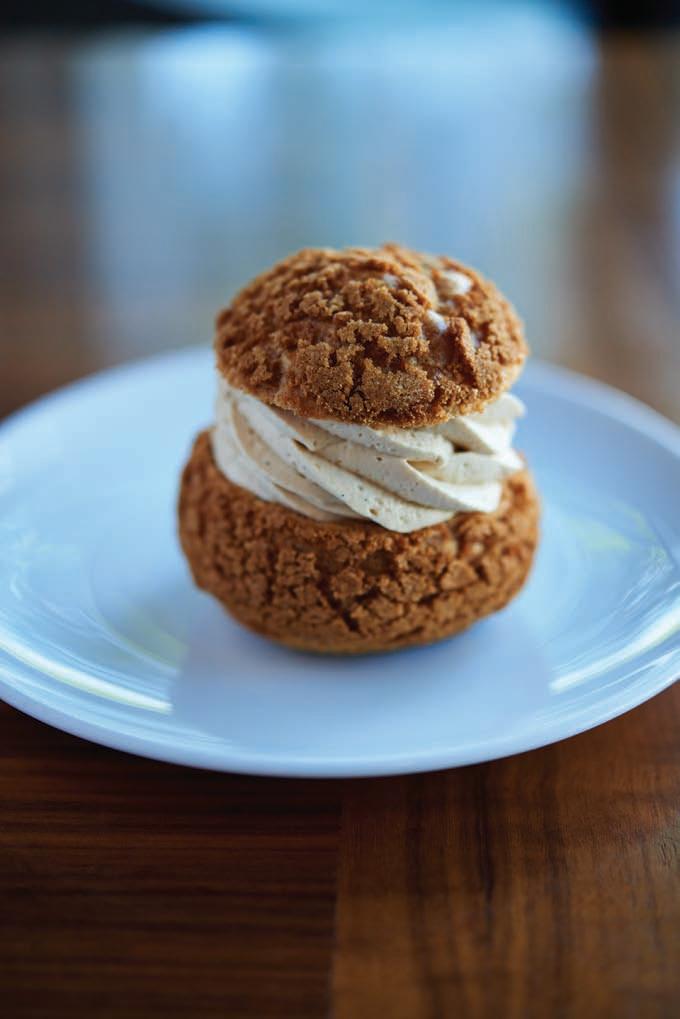
2360, rue Notre-Dame Ouest Montréal 514 439-5434 patricepatissier.ca
PICTURED ABOVE: CHOU A LA CREME: BANANA, CHOCOLATE AND CARAMEL.
35
Date Night in Sidney
With its unique offerings, beautiful oceanfront setting and charming qualities, Sidney by the Sea is the ideal date night location.
What could be more romantic than a walk along Sidney’s waterfront with breathtaking views of Mount Baker? Impress your date and try your luck at fishing or crabbing from Bevan Pier. If the fish aren’t biting, check out all the freshly caught ones for sale at the Satellite Fish Market located in the historic blue building on the Sidney Pier.

If your special date prefers the outdoors, rent a kayak or boat from Port Sidney Marina for a half or full-day adventure. If you’ve never kayaked, plan to take some lessons or a sunset guided paddle.

It's easy to make the connection between romance, great food and music. Haro’s Restaurant & Bar, the Beacon Landing Restaurant, and The Surly Mermaid each feature excellent food, live entertainment (schedules vary) and stunning ocean views.


Take pleasure in the ambiance of one of Sidney’s neighborhood pubs, all featuring local beers and wines. Sip a custom crafted libation at Victoria Distillers, located right on the waterfront. Enjoy a wine and cheese flight at The Farmer’s Daughter or select your own items from their deli counter to create the perfect picnic.

Take your date for a night of friendly competition. Miracle Lanes has a retro vibe with five-pin bowling and pool tables, a definite must do.
And remember, Sidney’s hotels and spas offer a wide range of couple’s packages, so why not treat your loved one to a local getaway?
To plan your date and learn more about downtown Sidney’s diverse offerings, check out distinctlysidney.ca





PLAN YOUR DATE
distinctlysidney.ca







36 SEPTEMBER/OCTOBER 2018
Good for you EAT BASIL

Like many people around the world, I’ve fallen under the spell of an aromatic, leafy green herb. In fact, I’m addicted to it. Before you raise an eyebrow, allow me to clarify. I don’t get my “ fi x” from a dispensary—the herb I’m besotted with is the culinary “King of Herbs”— basil. Clearly, I am not alone in my love for the fragrant plant.
Basil has been used as a culinary and medicinal herb for millennia, and many cultures regard the herb with reverence. It seems there’s good reason for basil’s vaulted status. Not only does the herb deliver outstanding fl avor but nutritional science has revealed the aromatic plant is also abundant in good-for-you nutrients like Vitamins A and K, manganese, copper, and folate. In addition, it’s teeming with disease-fighting antioxidants , fl avonoids and health-enhancing oils. What’s more, preliminary evidence indicates this unique blend of nutrients may enhance health in surprising ways.
Cancer-foe



Several lab studies have shown that basil not only inhibits the growth of certain cancers, it also KO’s established cancer cells. What’s more, it may protect the body from oxidative stress and DNA damage; two factors believed to play a role in the genesis of the disease.
Heart-friendly
It seems the fragrant herb can please the heart as well as the palate. Basil protects the cardiovascular system by helping to lower blood pressure and cholesterol, promote the relaxation of blood vessels, and suppress in fl ammatory enzymes in the body. Not surprisingly, researchers have concluded basil may be an ally in the treatment and prevention of heart disease and stroke.
Anti-inflammatory



Research conducted at the Swiss Federal Institute of Technology revealed that basil is teeming with E-beta-caryophyllene (BCP), a powerful anti-in fl ammatory agent. Scientists believe this compound may be a valuable adjunct in the treatment of arthritis and other in fl ammatory conditions.
Brain-booster
Basil may not just enhance your pasta, it may also enhance your cognitive function. Oral supplementation of the herb improved the locomotor-skills, neuromuscular coordination, memory retrieval and learning ability in adult mice. While it’s too soon to say whether basil will have the same beneficial effects in humans, it’s certainly not too soon to enjoy the health-enhancing herb more often!
Getting the Most
Thankfully, there’s a world of possibilities when cooking with basil. Aside from classic dishes like pesto and Caprese salad, there are myriad ways to include the herb in your culinary repertoire. While it’s certainly a mainstay in Italian cuisine, it also features heavily in Thai, Vietnamese, and Greek cuisine. And who can prepare West Coast fare without utilizing basil for its bright, fresh fl avor? One of my favourite ways to use the herb is in healthy spreads. I love a mix of Greek yoghurt, mashed avocado, sea salt, and basil spread over crispy sourdough toast. I’ve also discovered basil adds life and contrast to my fruit-based smoothies. Another delightful discovery has been highlighting basil in desserts. Yes, you read that right, desserts. Lemon basil cupcakes, cantaloupe-basil sorbet, and key-lime basil pie are just a few of the sublime after-dinner-treats I’ve sampled in the past months.
You may be wondering if you should use fresh or dried basil. While many fresh foods are more nutritious than their dried counterparts, basil is good both ways. Your best bet, researchers say, is to make liberal use of both forms of the herb. I certainly won’t argue with that recommendation!
WE STEAK OUR
IT ISLAND RAISED 2032 OAK BAY AVE
REPUTATION ON
PAM DURKIN 37
POTATO GNOCCHI
TEXT: DENISE MARCHESSAULT
PHOTOS: DEB GARLICK
When I learned gnocchi was one of Gary Hynes’ favourite dishes, it seemed onl y fi tting to feature this “how to” guide for creating this simple, heart-warming recipe.


This darling of a dumpling is sometimes confused with pasta. It’s no wonder — they’re often found in the fresh pasta section of the grocery aisle and featured on restaurant menus with the pasta entrées. (Never mind that Italians serve both as Primi Piatti, a first-course dish.)
Gnocchi, however, are made from potatoes. Calling them pasta is akin to ordering an EX-presso (rather than espresso). Aficionados within earshot will set you straight.
When I tell friends how easy it is to prepare gnocchi, I get doubtful looks, followed by, “Maybe for you. I’ll stick to store-bought, thanks.”
If you’re accustomed to vacuum-packed gnocchi, homemade are a revelation. The two are not the same: one melts-in-your-mouth, the other, well, you’ve had the other.
The process is straightforward but, like most recipes with few ingredients, it’s about technique and feel, rather than measured ingredients.
Smooth or etched, served tender or sautéed crisp, gnocchi re flect the temperament of the chef. Once you’re comfortable with this base recipe, you can tinker with variations. The addition of sweet potato, for example, imparts a lovely shade of rust and minced kale tinges gnocchi verdant green. Some chefs amp up the colour with unsettling shades of purple (Peruvian potatoes) and garish red (beets), but I draw the line at black gnocchi, even if squid ink is a delicacy.
A purist at heart, I prefer my gnocchi as plain and simple as the potato itself. I suspect Gary would have felt the same.
masterclass
38 SEPTEMBER/OCTOBER 2018
HOW TO
Turn the dough ont o a fl our-dusted work surface and gradually incorporate just enoug h fl our to form a soft, pliable dough. (You may not need all the fl our.) Knead brie fl y, just until the dough comes together.

Divide the dough into 6 equal parts. Roll each portion ont o a flour-dusted work surface and shape into a rope an inch thick by 12” long, using the palms of your hands (as pictured). Line up the “ropes” and cut them into 3⁄4” pieces. You can leave the pieces as is or etch grooves in them by pressing each portion against a gnocchi paddle (or the tines of a fork). Spread the gnocchi ont o a floured-dusted baking sheet.


POTATO GNOCCHI
Serves 8 - 10 as an appetizer or starter
Gnocchi can be prepared in advance and re-heated, making it the ultimate company dish.


If you’re planning to serve gnocchi straight away, ensure your butter sauce ingredients are pre-measured.
Ingredients
5 large Russet potatoes, about 2 ½ - 3 pounds, washed but not peeled 1 egg yolk, lightly beaten 2 tsp kosher salt approximately 1 3/4 cups all-purpose flour
Special Equipment
Food mill or ricer (for processing the potatoes)
Gnocchi paddle, optional (for imprinting grooves into the gnocchi to catch the sauce)
Preheat oven to 350ºF.
Pierce the unpeeled potatoes with a fork (fi ve stabs will do the trick) and bake until tender, about an hour or more depending on the size. (Piercing the potatoes releases the steam that can otherwise build up and burst the potato.)
When the potatoes are fork tender, remove them from the oven and slit them open lengthwise to allow the steam to dissipate. While the potatoes are still warm, peel and press though a ricer or food mill into a large bowl. Add the yolk, salt, and about half of the flour.
Mix together with a fork until a soft dough comes together.
Butter Sauce
Place a strainer, or slotted spoon, near the stove and bring a large pot of generously salted water to a boil. Drop the gnocchi into the boiling water in batches, being mindful not to overcrowd the pot. When the gnocch i float to the surface, scoop them out with a strainer, without delay, and transfer them to your sauce. (Save about a cup of gnocchi water for your butter sauce.)

To Prepare Gnocchi in Advance

If not serving immediately, place a large bowl of icewater near the stove, before you cook the gnocchi. Follow the cooking instructions above, then transfer the just-cooked gnocchi to the bowl of ice water. Drain the chilled gnocchi, transfer to a shallow container, toss with a bit of olive oil, cover and refrigerate. (Best used within 24 hours.) To reheat gnocchi: heat 1 Tbsp oil or butter in a skillet. Add the gnocchi and toss until warmed through. Serve with your favourite sauce.
about 1 cup water from the gnocchi pot * 1 cup cold unsalted butter, cut into cubes

1 tsp fresh lemon juice, plus more as needed
1/2 tsp kosher salt
freshly ground pepper, to taste
2/3 cup grated Parmesan cheese, plus more as needed sprig of fresh thyme
* The starch in the gnocchi water helps the sauce cling to the dumplings. (Tap water will do in a pinch.)
In a small saucepan bring about 1⁄2 inch of gnocchi water to a simmer. Whisk in the butter, a few cubes at a time, over medium heat without boiling. Add the lemon juice, salt and pepper. Taste and season with additional lemon and salt if desired. Toss the gnocchi in the sauce until coated and warmed throughout. Portion onto small warmed bowls; add a generous pinch of Parmesan and garnish with thyme. Serve immediately.
A RICER PROCESSES
COOKED POTATOES INTO FINE RICE-SIZE PARTICLES
PORTION THE DOUGH INTO MANAGEABLE PIECES
CUT THE “ROPES” INTO BITE-SIZE PORTIONS
IF YOU PREFER GNOCCHI ETCHED WITH RIDGES, PRESS THE DUMPLING ALONG A GNOCCHI PADDLE OR THE TINES OF A FORK.
ROLL THE DOUGH INTO “ROPES” ON A WELL-DUSTED WORK SURFACE
A SIMPLE BUTTER SAUCE CAN BE WHIPPED UP IN MINUTES
FOR THE MOST TENDER GNOCCHI, WORK WITH POTATOES WHILE THEY’RE STILL WARM
39
WILD RICE AND MUSHROOM CABBAGE ROLL
TEXT: ISABELLE BULOTA
PHOTOS: REBECCA WELLMAN
Although the direct heritage of cabbage rolls cannot be certain, its lineage can be traced back over 2,000 years. Recipes vary depending on region; Romanians and northern Poles prefer a savoury sauce, Ukrainians favour sweet-and-sour. Many variations of this traditional dish have since then been adapted throughout numerous cultures. Here is my version of this well-known classic. With our love for comfort food, this is one that we can easily crave and eat for days. The rolls swell and cook when they are smothered in the tomato sauce and become these perfectly compact and delicious bundles of gastronomic joy.
 Isabelle Bulota’s
Isabelle Bulota’s
40 SEPTEMBER/OCTOBER 2018


RECIPE ON THE NEXT PAGE 41
Cabbage, Wild Rice and Mushroom Filling
1 cup wild rice blend

1 ¾ cup chicken broth
1 head cabbage (for 12 large cabbage leaves)
225 gr bacon diced (1 cup)
1 small onion finely chopped
340 gr mixed mushrooms (button, cremini, and shiitake), sliced (4 ¼ cups)
2 cloves garlic
¼ cup dry white wine
450 gr ground pork (2 cups)
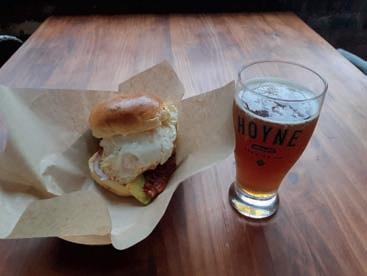

2 Tbsp chopped fresh chives
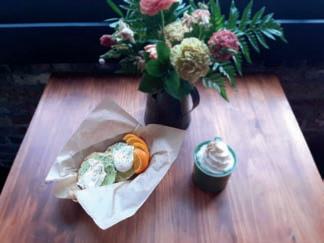
kosher salt and black pepper

Proceed to cook the rice according to the package directions, replacing the water with the equivalent amount of chicken broth. Place the rice in a large shallow dish to let it cool.
Boil 2 litres of water and add 1 tsp of salt. Remove the centre core of the cabbage with a knife. Completely submerge the whole cabbage and cook until the leaves are pliable and start to peel off, about 5 minutes. Using kitchen tongs or a fork, peel off a nd take out loosen outer cabbage leaves from the pot.
Soak the cabbage leaves in iced water to stop the cooking process. Pat dry with paper towel to remove excess water from them. Trim the tough, thick centre vein at the base of each leaf (upside-down V shape) chop the vein and keep aside to add to the rice later.
Cook the diced bacon over medium heat in a large skillet; until cooked through, but still chewy and not too crisp. Remove with a slotted spoon to a paper towel-lined plate. Set aside.
Drain the grease from the pan, leaving 1 Tbsp of grease behind.
Add the onions to the pan and cook over medium heat, about 3 minutes. Add the mushrooms, 1⁄2 tsp salt, and 1⁄4 tsp pepper. Cook, occasionally stirring, until browned, 5 - 7 minutes. Add the garlic and cook for one more minute.
Add the wine and cook, scraping up the brown bits, until evaporated, 1 to 2 minutes. Remove from the heat and set aside to cool.

Once the rice and mushrooms have cooled down, fold in the pork, chopped cabbage veins and chives.
For the Sauce

1 Tbsp olive oil

2 bay leaves
1 clove garlic chopped finely
1 can (796 ml/28 oz) diced tomatoes
1 Tbsp white wine
½ tsp kosher salt

1 cup chicken broth
In a large pot, heat the olive oil on medium heat and cook 2 bay leaves and garlic until fragrant. Then stir in the diced tomatoes. Reduce the heat to medium-low. Add the white wine, 1⁄2 tsp salt, and freshly ground black pepper, and bring it to simmer on medium heat.
2577 Cadboro Bay Road, VICTORIA 592-0823 TURKEY
YOU’LL HIDE THE LEFTOVERS.
Poultry and Game Birds, Quality Meats, Cheeses, Specialty Products & Condiments 3:16 PM Page 1
SO GOOD
“Free-Range”
42 SEPTEMBER/OCTOBER 2018
Putting it all together



Starting with the stem end, roll the cabbage up tightly, tucking in the sides of the leaf as you roll. Use one hand to pull the edge of the leaf and roll the fi llings tightly toward the edge. Repeat with the remaining leaves and stu ffi ng. Place the cabbage rolls side by side in rows, seam side down, on top of the prepared sauce. If there are open spaces, stu ff t he leftover cabbage in the opening so the cabbage rolls won’t move around while cooking. Pour 1 cup of chicken broth on top.

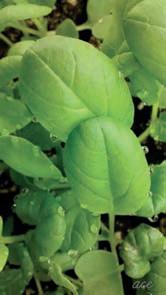
Cover and cook on medium-high heat. After boiling, lower the heat to medium-low and simmer for 35-40 minutes. When you are ready to serve, remove all bay leaves from sauce, carefully pick up the stu ffed cabbage rolls one at a time with kitchen tongs and put in a serving dish and pour the sauce on top or serve separately.
Garnish with a parsley and lemon topping and serve.




To make the parsley and lemon topping
Using a vegetable peeler, remove peel in long strips from 1 small lemon. Mince lemon peel. Transfer to a small bowl. Mix in 1⁄2 cup of fi nely chopped parsley and 2 Tbs of fi nely chopped shallots. The topping can be made in advance and kept covered and refrigerated.
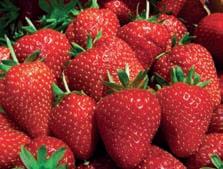

Wine pairing: try Malbec or Zinfandel.



Welcome to a Food Lover’s Exotic Cheese and Chutneys Gourmet Oils and Vinegars South African Imported Foods 250-754-0100 426 Fitzwilliam Street the bigcheese@ mcleansfoods.com www.mcleansfoods.com Established 1992 in Nanaimo’s Old City Quarter Farms, Food, Art, Crafts & Fun 100Overstalls LOCAL
43
FARM TO TABLE SOUTHERN GULF ISLANDS



It’s Harvest Time in the Southern Gulf Islands and we couldn’t be happier! These islands have a long history of being a proli fi c source of food , fi rst as hunting , fi shing and foraging grounds for surrounding First Nations peoples to farm land of early settlers to the area. By necessity, residents to these islands were a self-su ffi cient bunch, and with hard work and excellent growing conditions due to our Mediterranean micro-climate, Gulf Island residents had success in farming and growing fruit. Salt Spring Island is a great example of this early success and was at one point the “Apple Capital of Western Canada” with over 300 varieties the apple harvest rowed to Vancouver for sale in BC and neighbouring provinces.
Today, the theme is farm-to-table bounty, most of it organic, and communities with thriving farmers, chefs, restaurants and food producers. Feeding local residents and visitors to our islands is a passion and each island o ff ers Farmers Markets, usually on the weekends, and honour box farm stands selling eggs, produce, fl owers, jams, tea and preserves. Food lovers from all over the world are blown away with the quality and taste of what we produce here.
The Gulf Islands is also a unique growing region for BC wine. Flavours here are noticeably di ff erent due to our terrior, with subtle di ff erences in th e fl avours due to salt content in the soil from the ocean and the cool climate creating crisper whites and light varietal reds. Several award winning wineries can be found here along with cideries, breweries, distilleries and beverages including tea, kombucha and small batch co ff ee roasters.

Culinary adventure tours are becoming popular along with outdoor long table dinners where guests enjoy food, drink and music from our islands. These events can now be found year-round both through private restaurants and farms to community based non-pro fi t fundraisers, supporting our culture and way of life. Some islands are o ff ering tour operators where others are self-guided tours.
Enjoy Galiano Island’s festivals and arts scene including the Kunamokst Mural, along with hiking delights. Mayne Island o ff ers laid-back charms, markets and dining options and beautiful views from the Georgina Point Lighthouse. Pender Island o ff ers two islands to explore, beaches and seaside vistas, great dining and
shopping, and vibrant friendly people with community spirit to share! Visit Salt Spring for our Saturday and Tuesday Markets and stay for cultural options where you are surrounded by parks to play in. Saturna o ff ers an abundance of nature including East Point Park and the famous Saturna Lamb BBQ! Annual Festivals and Events are on year-round on all our islands with the focus on fun!
For places to stay, beautifully appointed B & B’s abound in forest, farm or ocean settings with inspired breakfasts featuring locally sourced ingredients. Lakefront cabins and cottages are great for families and groups. Camping is very popular in the Gulf Islands and includes BC Provincial Parks, National Parks and private campgrounds. There are also yurts, tipis and converted Airstream trailers. Resorts, hotels and spas round out the mix, with choices that meet the needs of higher-end travellers. Weddings are popular here as are wellness retreats, business meetings and family reunion.
Learn more at southerngul fi slands.com and plan your next culinary adventure!
JON SUK, SOUTHERN GULF ISLANDS TOURISM 44 SEPTEMBER/OCTOBER 2018
WE GO TO EXTREMES TO BE TRULY LOCAL...







Hundreds of products made on Salt Spring Island.





















 Country Grocer – Salt Spring Island, your source of extremely local products.
Country Grocer – Salt Spring Island, your source of extremely local products.
edaM r i g ht hereonSalt SpringIslan d l ! • Local isbetter • 45
DUNCAN
Duncan Garage Café & Bakery
Take a refresher course in warmth this fall. Start with our super food chai and continue with a soup or stew or both! Packing lunches? We have everything you need from ‘er soup to a nutty dessert.
330 Duncan St., Downtown Duncan (across from the railway station), 250-748-6223
Hudson’s On First
Award winning dining in a beautifully restored heritage home. Local ingredients, classic techniques and made from scratch cooking are a just few reasons to visit us in Duncan more often.

Celebrate Bubbles & Brunch, Lunch and Dinner.
163 First St. Duncan, BC, 250-597-0066, hudsonsonfi rst.ca
MATTICK’S FARM
Adrienne’s Restaurant & Tea Garden
Watch for our Oktoberfest menu. Try our ALL DAY BREAKFASTS or spend an afternoon with us for Ploughman’s platter, High Tea, or desserts and drinks. Kid-friendly menus are available. We buy local first.
Open daily, book your reservations, 250-658-1535. 5325 Cordova Bay Road, Victoria, BC, AdriennesTeaGarden.com

VICTORIA PUBLIC MARKET
Whisk
We are entering our fifth year of business at the Victoria Public Market. Thank you to all of our loyal customers and welcome to new ones. Come and check us out for great giftware, gadgets, cookware and friendly service.
At the Victoria Public Market whiskvictoria.ca Open 7 days a week HOME & KITCHENWARE
SOOKE
Stick in the Mud
The Stick has been roasting specialty coffee in Sooke since 2010. Freshly roasted wholesale coffee beans are now available in Victoria. Free delivery to the region. Commercial equipment also available.

Call for details. 778-352-0077
The Gary Hynes Foundation
LOCAL FLAVOUR
The Gary Hynes Foundation was established to continue Gary’s lifelong goal of helping others become the best they can be in the culinary, journalism and music disciplines.

This foundation will continue Gary’s work of giving chances, mentoring, supporting the food and beverage industry, believing in the power of the printed word, and loving a good bass line in a song.
All donations will go to scholarships for students studying in these disciplines. Please donate to keep his dream going using the URL link below.
www.vancouverfoundation.ca/hynes
WHISK Victoria Public Market 778 433 9184
46 SEPTEMBER/OCTOBER 2018
CONSISTENTLY EXCEPTIONAL. ALWAYS MEMORABLE.
Black Sage Road, Oliver BC • 1-877-498 -0620 burrowingowlwine.ca

We have so many delicious cuts of Sterling Silver® Premium Beef to choose from, you’ll have no problem finding the right pick for every occasion, from casual grilling to family dining to entertaining. Our meats are selected for quality, aged to perfection and custom-cut just for you.

THRIFTYFOODS.COM

47
after 111 issues, we say goodbye to EAT founder Gary Hynes 1950-2018




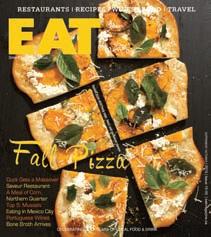












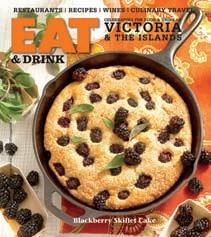

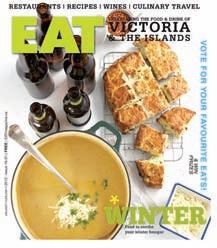





 ON FRONT AND BACK COVERS, A SELECTION OF ISSUES SPANNING THE YEARS 1999 TO 2018
ON FRONT AND BACK COVERS, A SELECTION OF ISSUES SPANNING THE YEARS 1999 TO 2018




















































































 CINDA CHAVICH
CINDA CHAVICH

































































































 CHEF LIAM FANNING
CHEF LIAM FANNING

 JOHN WINTER-RUSSELL
JOHN WINTER-RUSSELL








































 Isabelle Bulota’s
Isabelle Bulota’s






















































 Country Grocer – Salt Spring Island, your source of extremely local products.
Country Grocer – Salt Spring Island, your source of extremely local products.































